Features of drugs action during pregnancy, lactation and
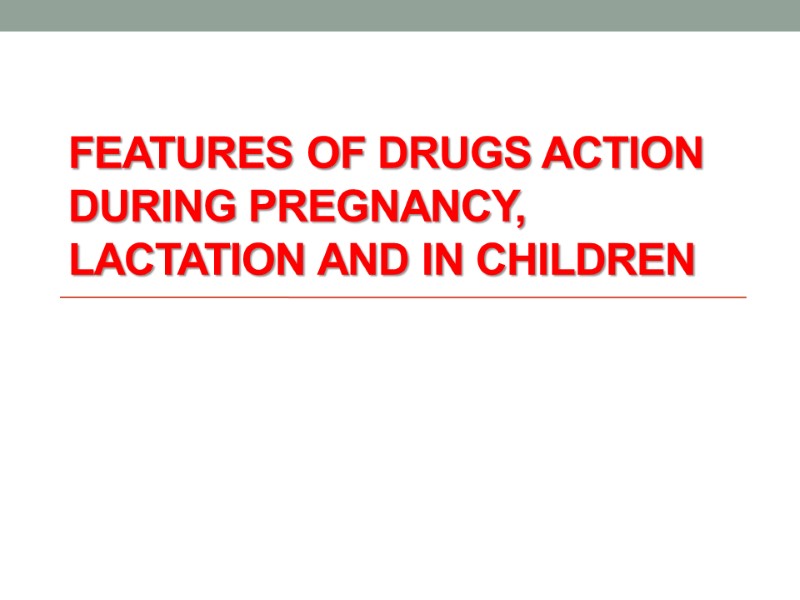
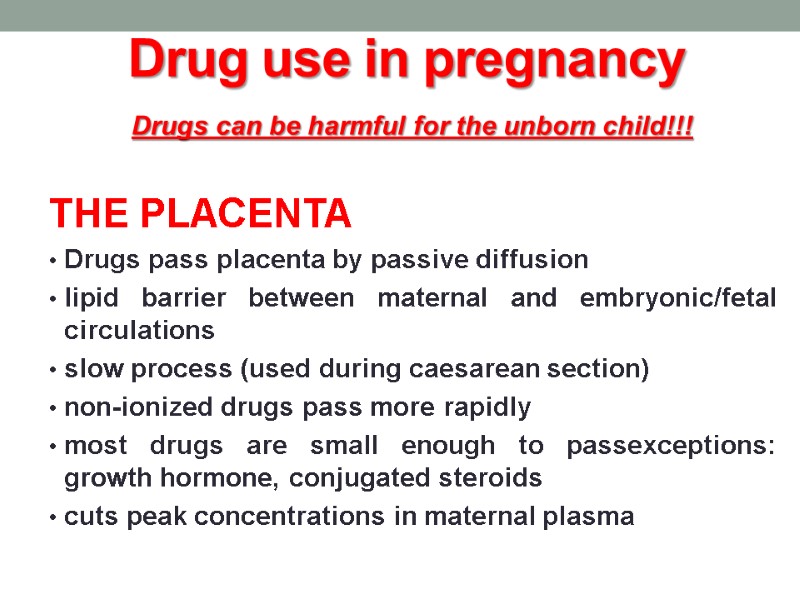
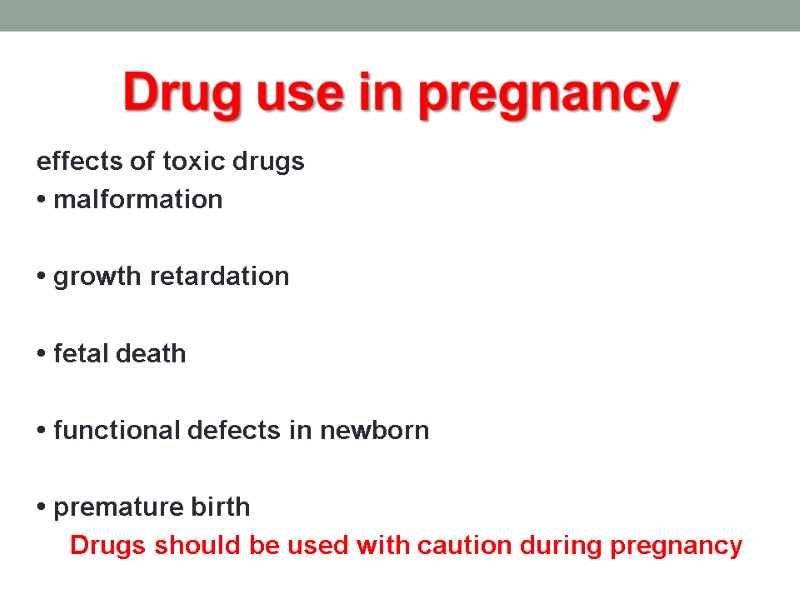
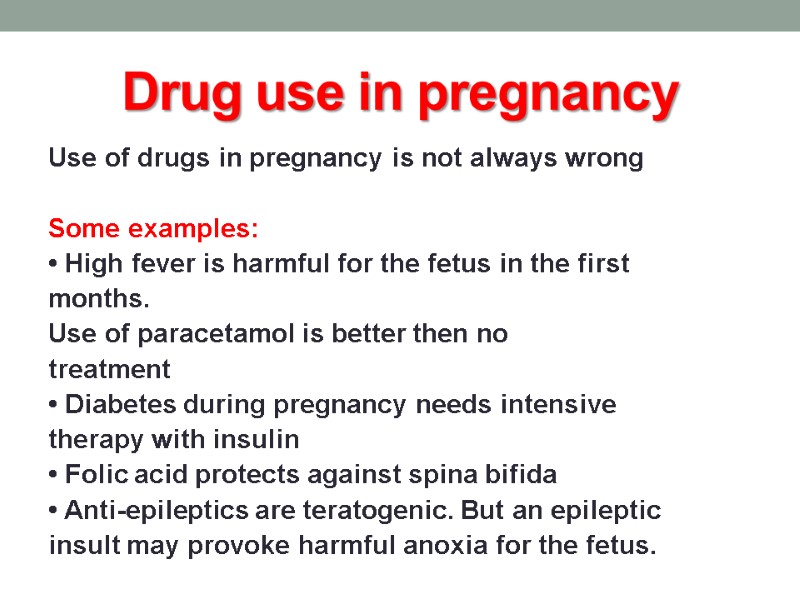
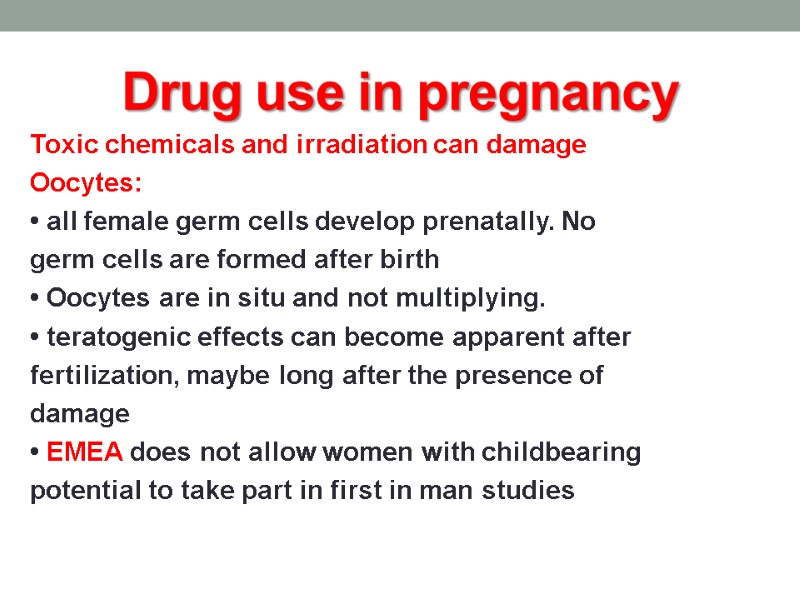
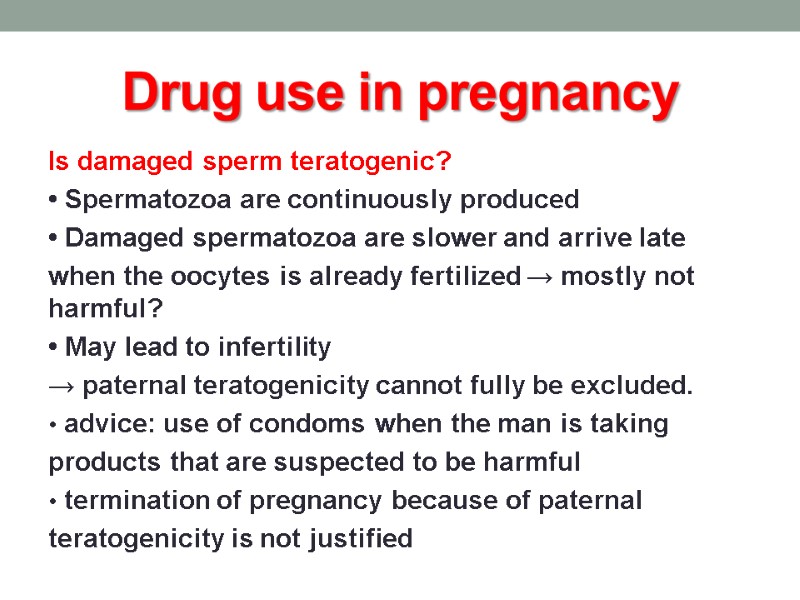
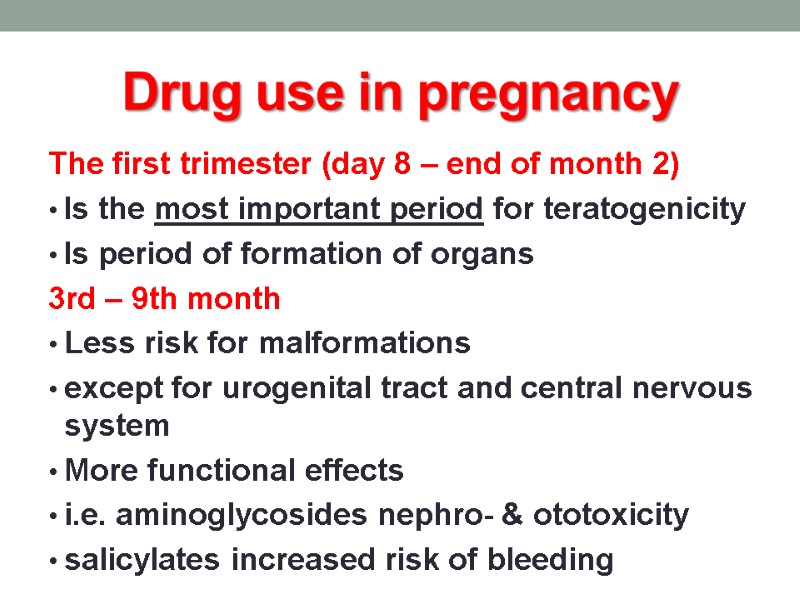
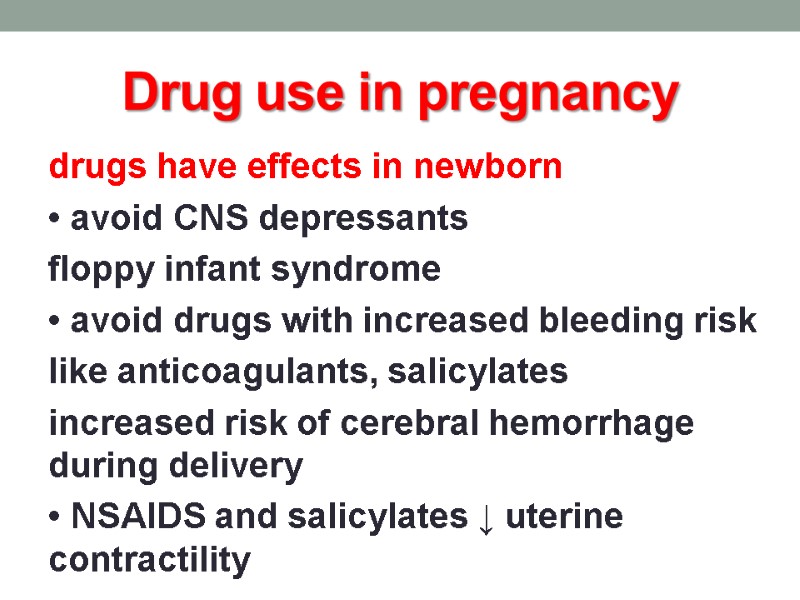

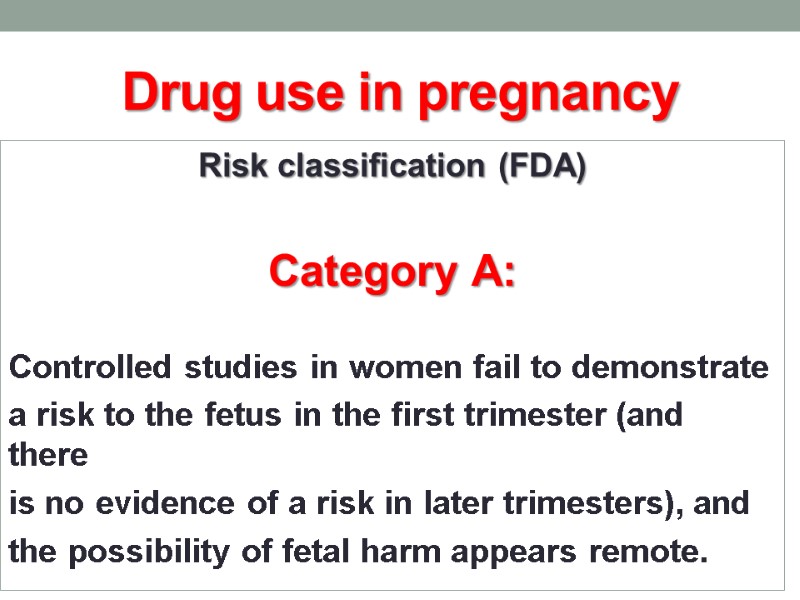
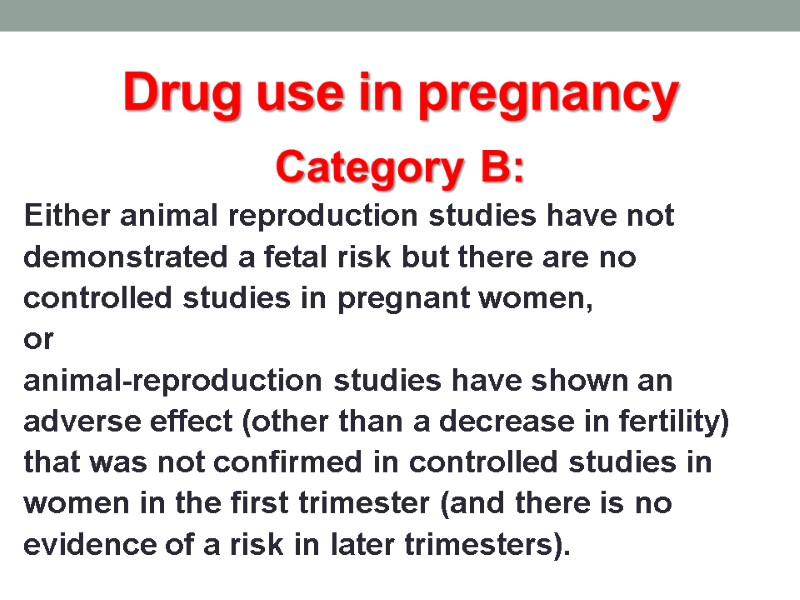
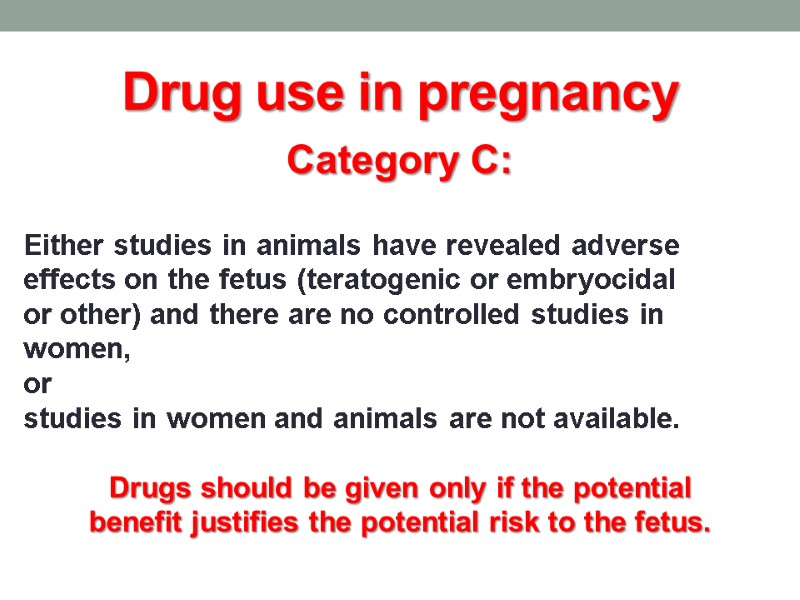
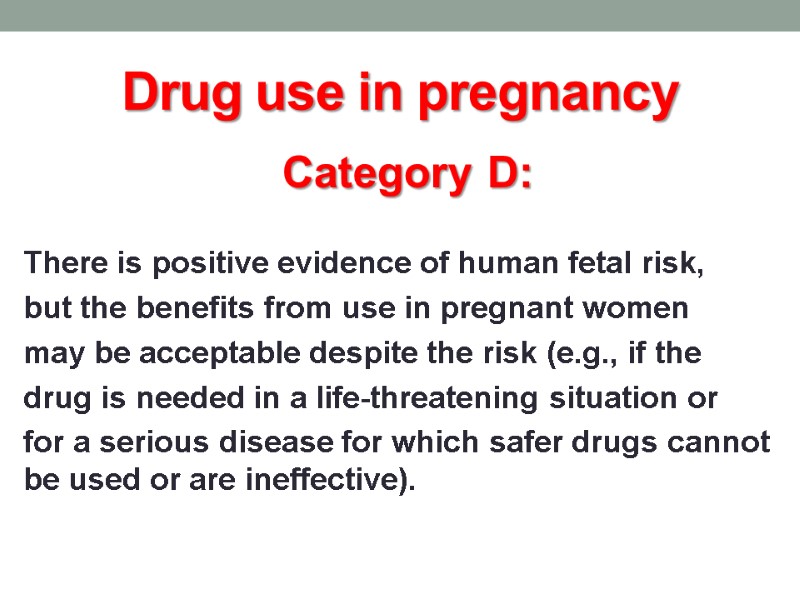
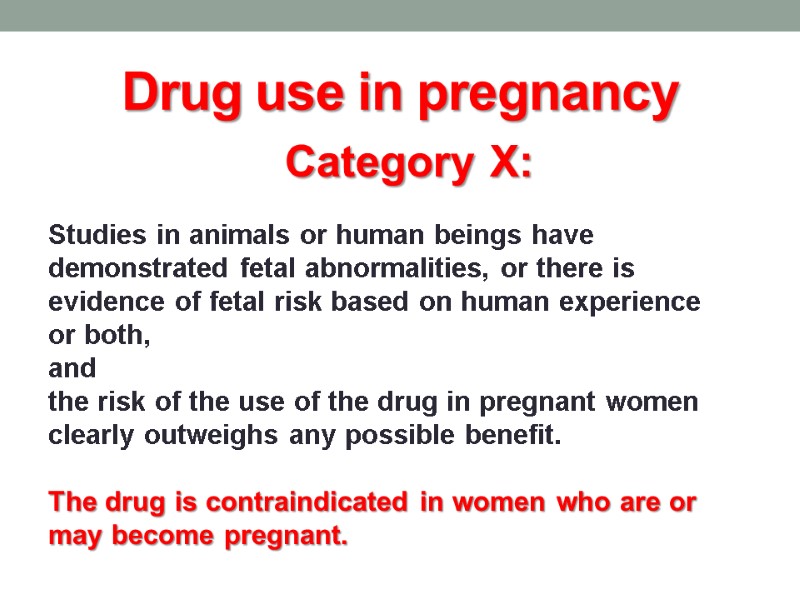
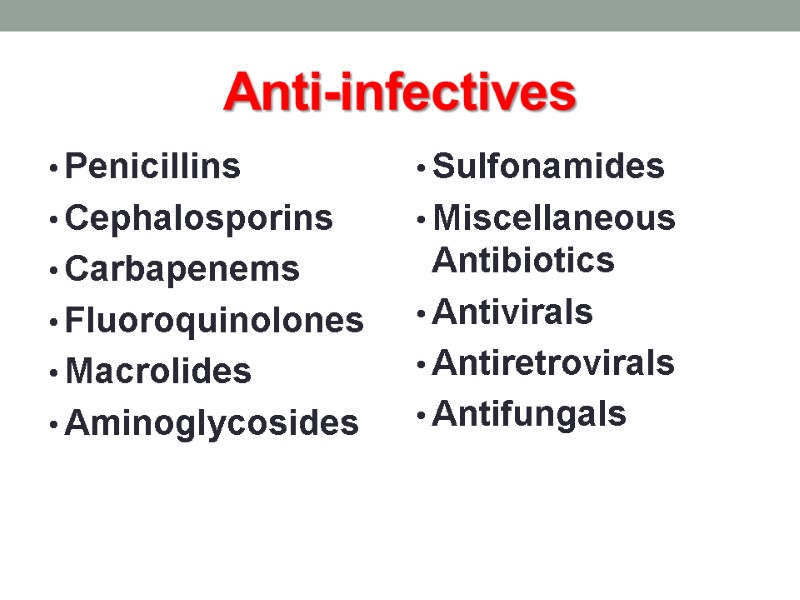
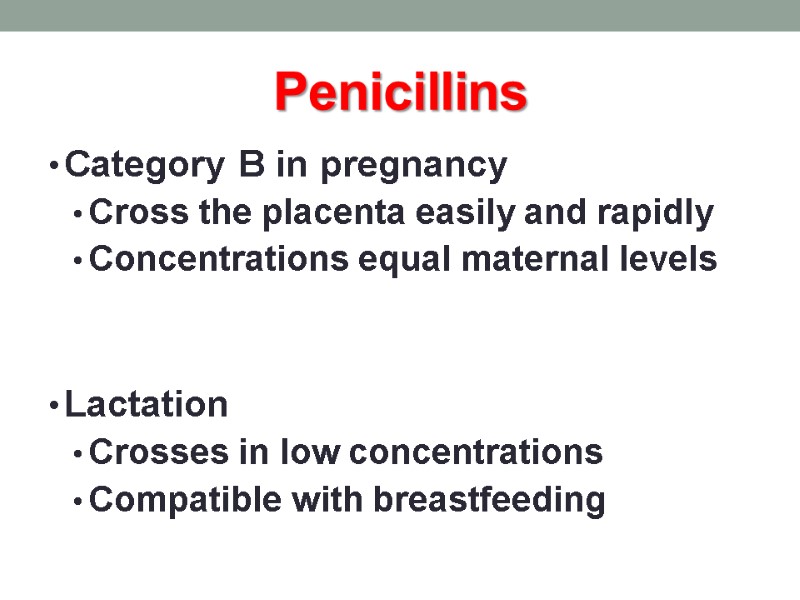
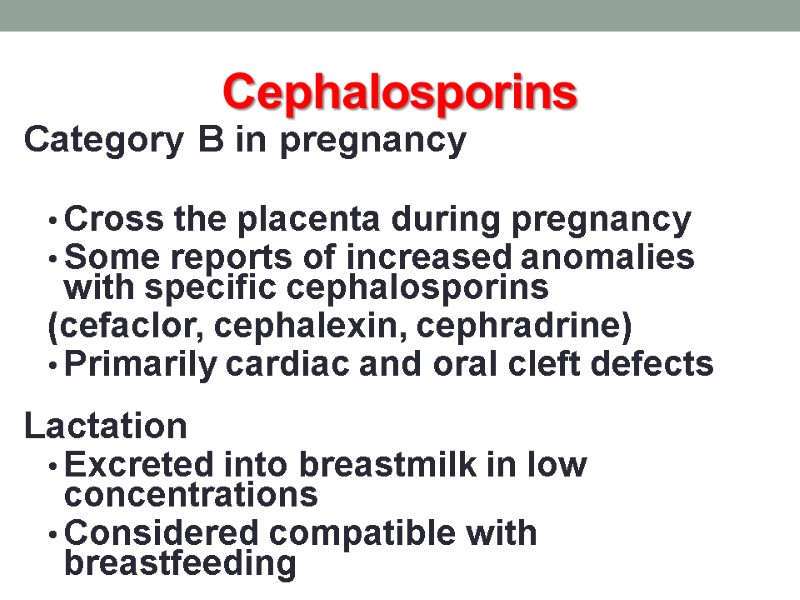
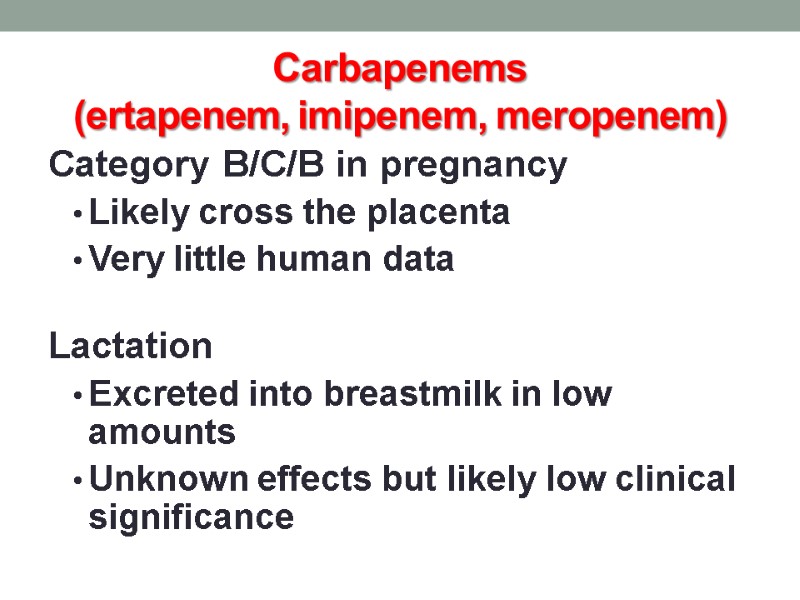
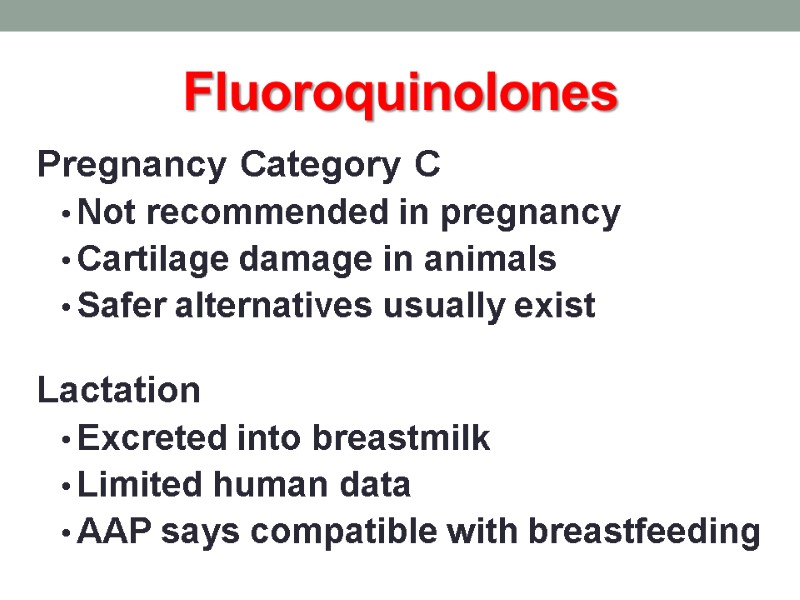
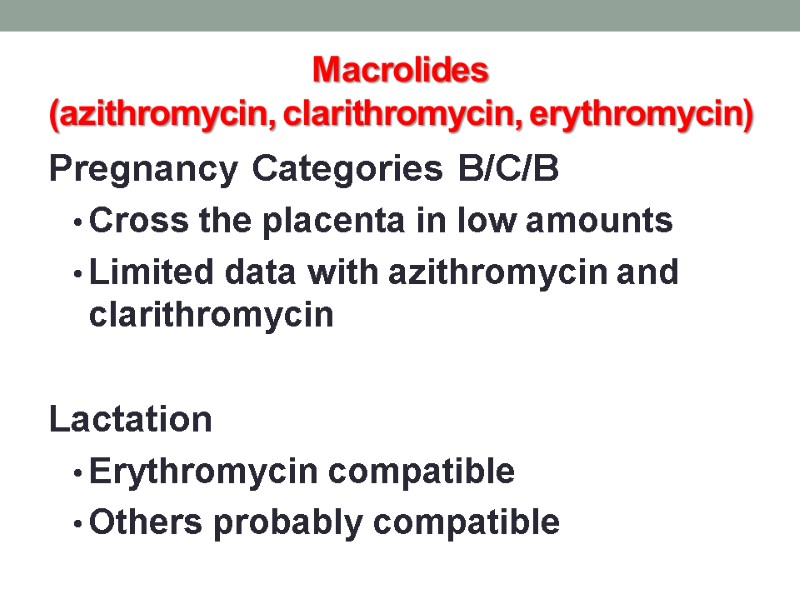
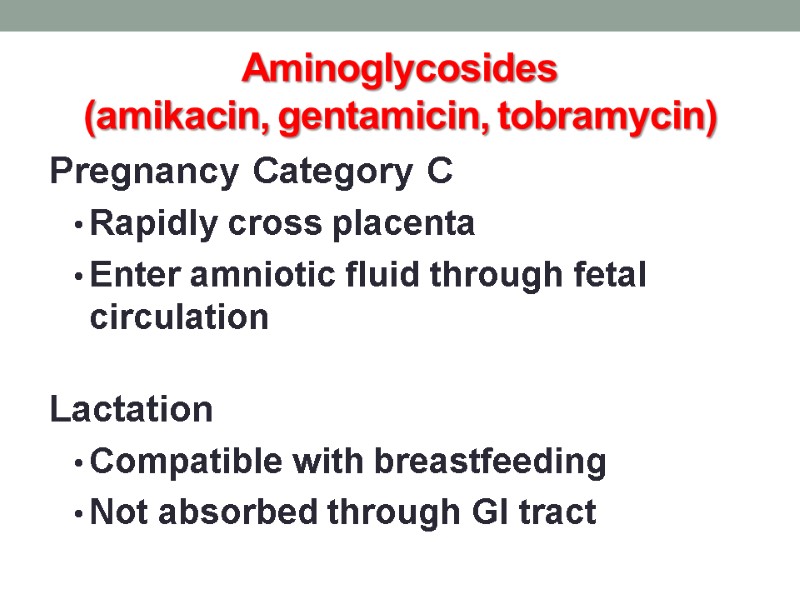
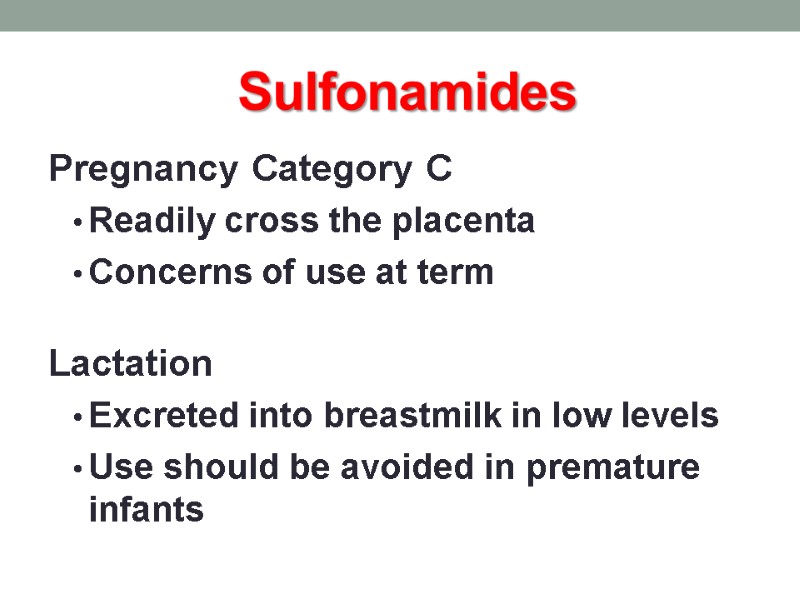
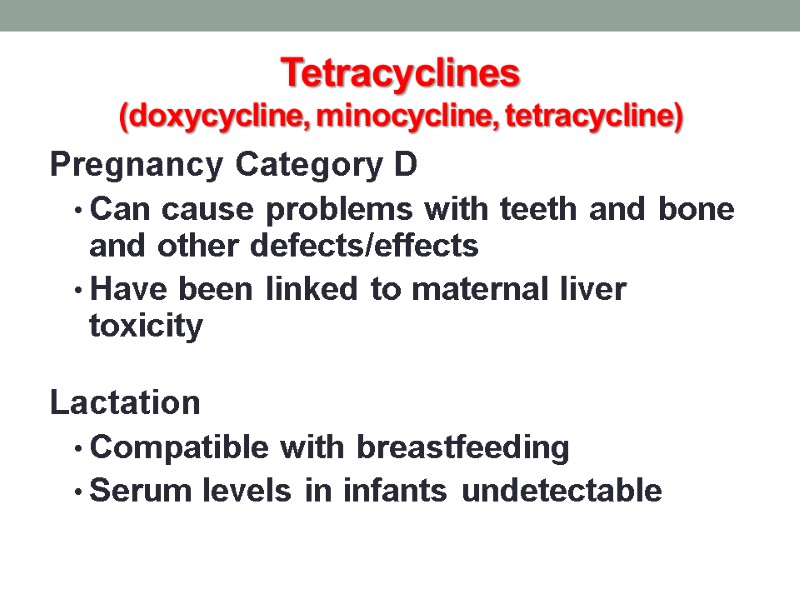
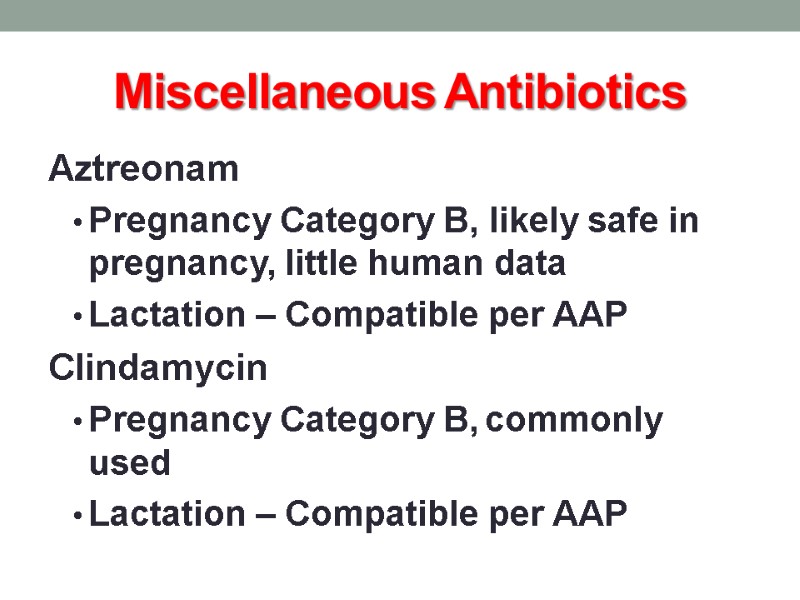
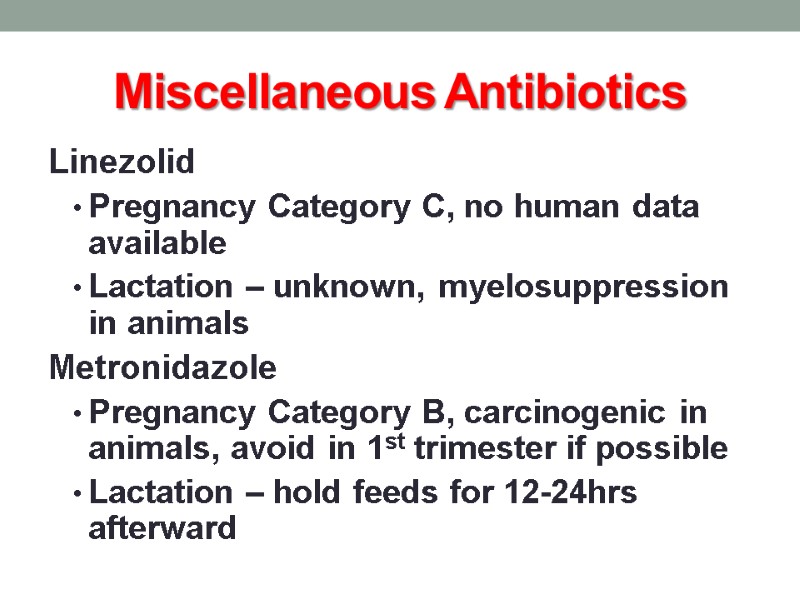
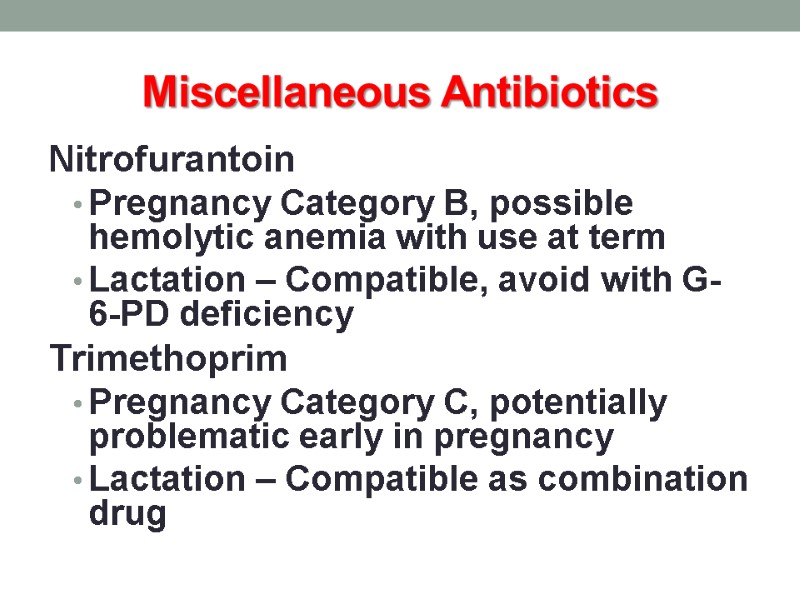
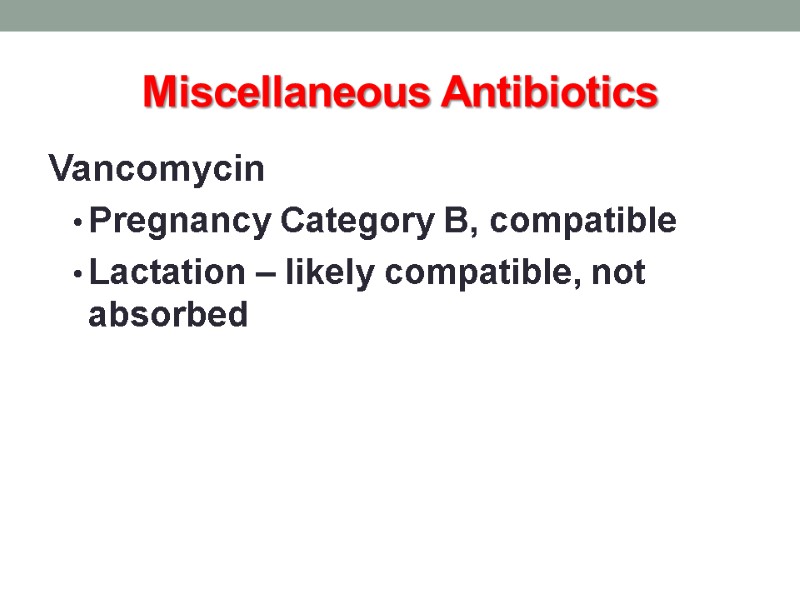
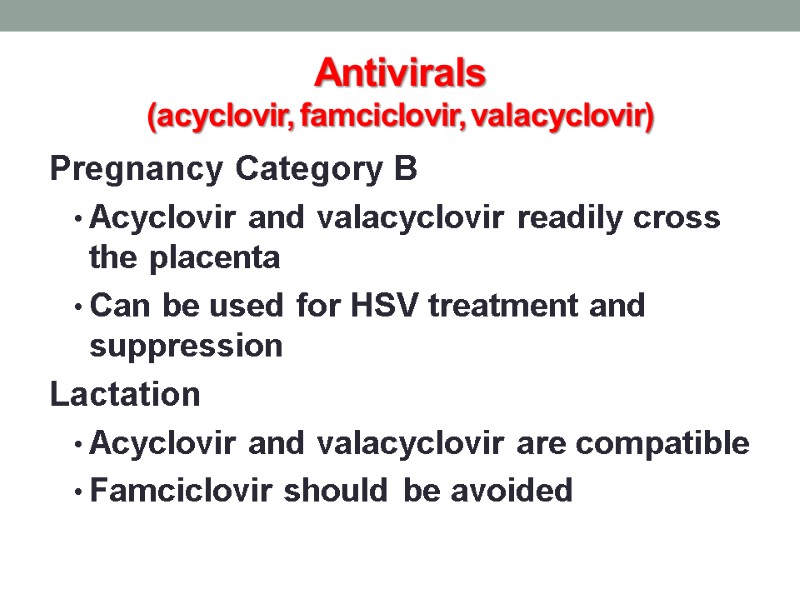
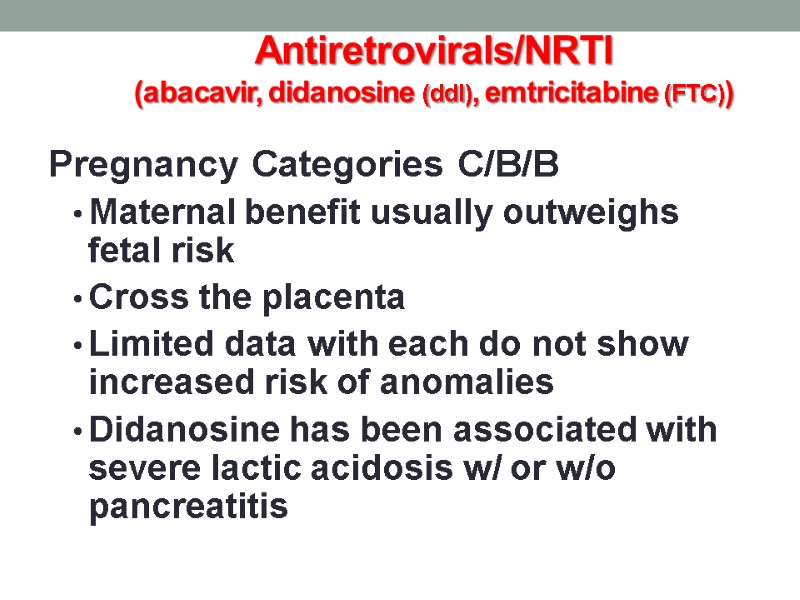
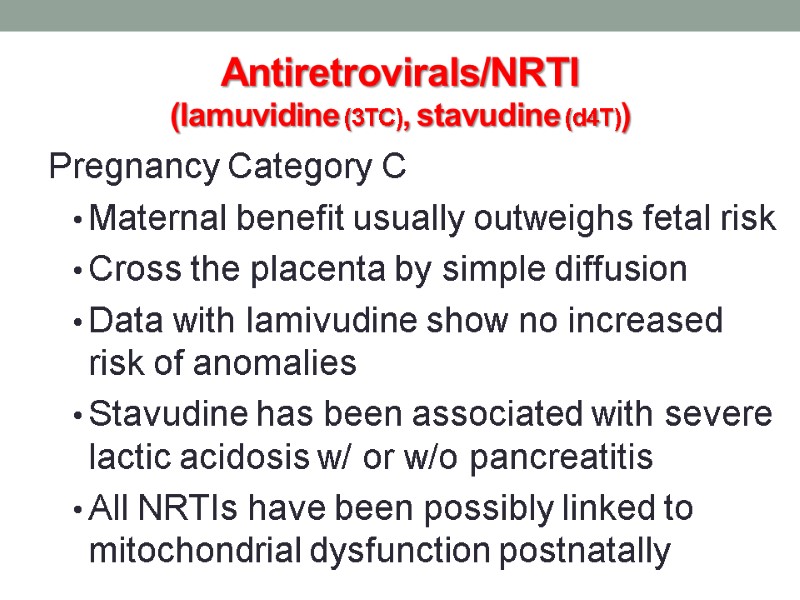
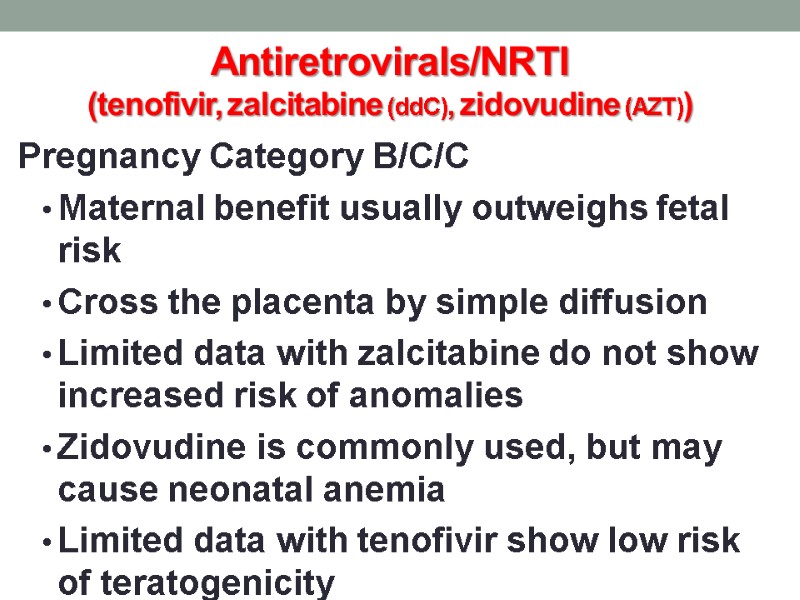
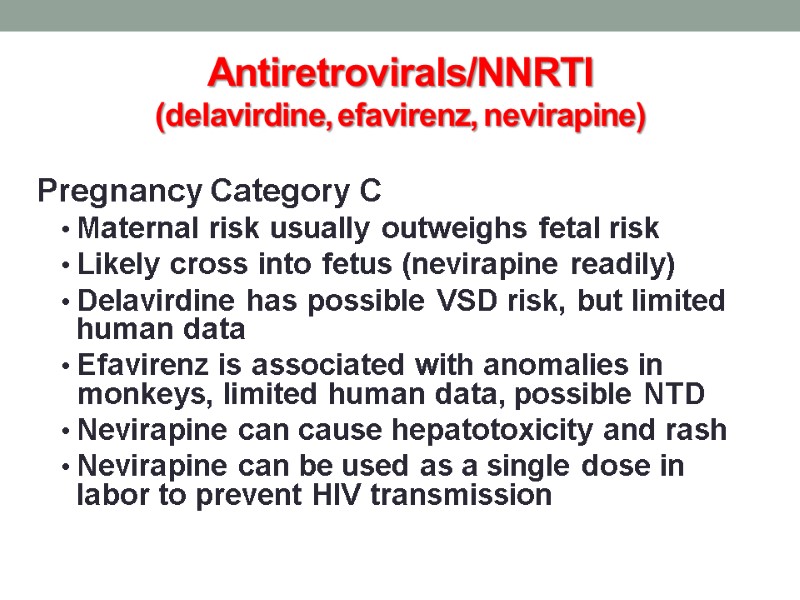
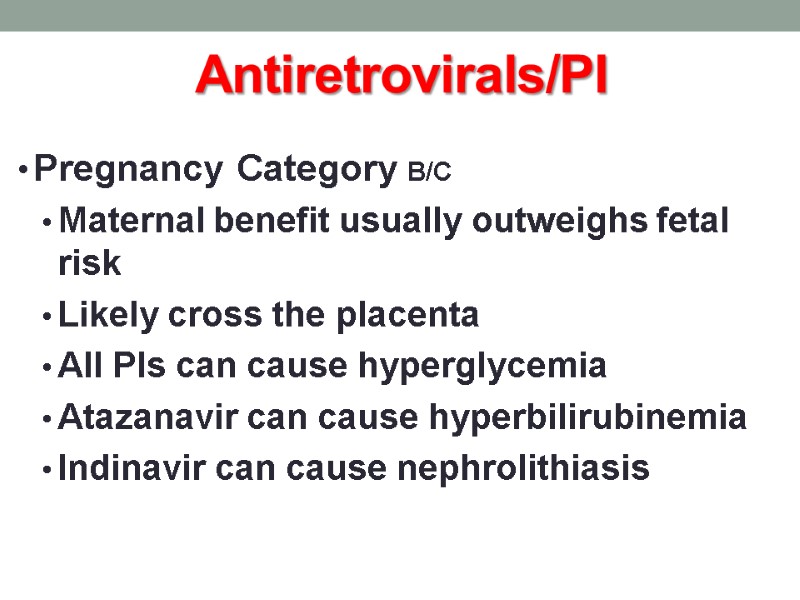
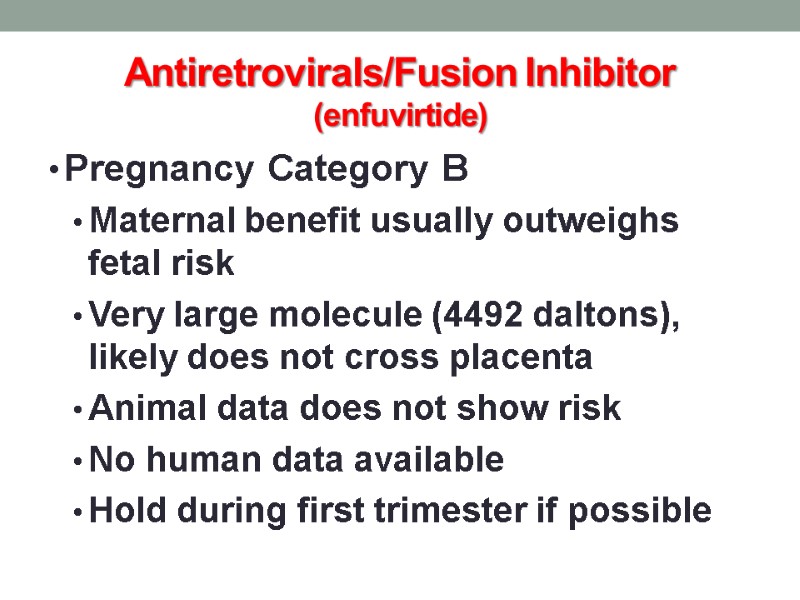
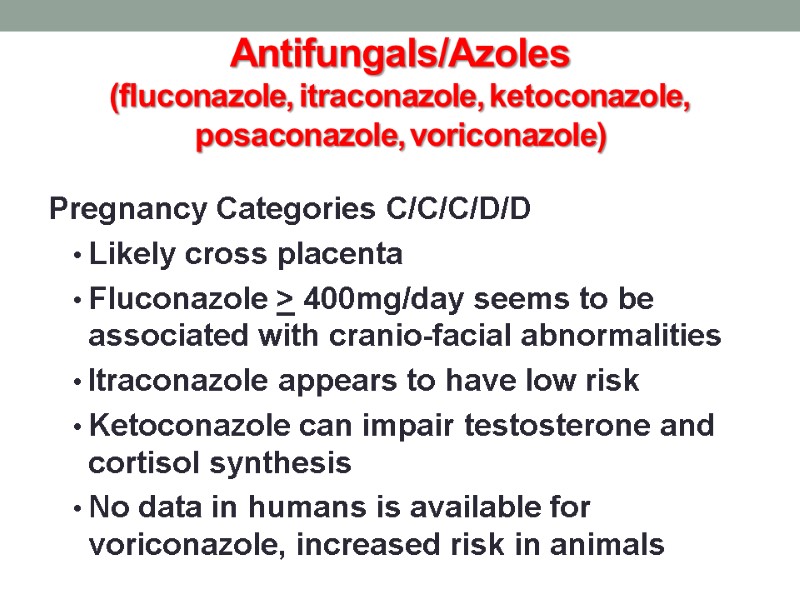
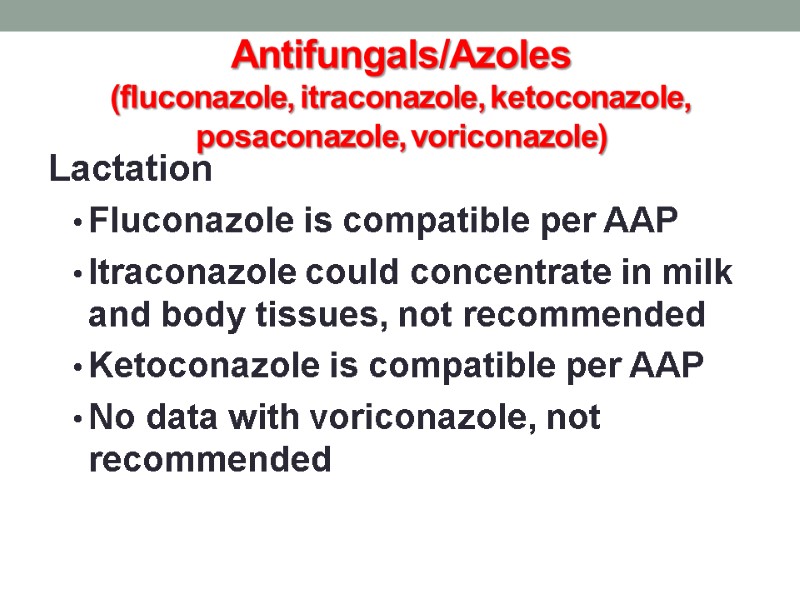
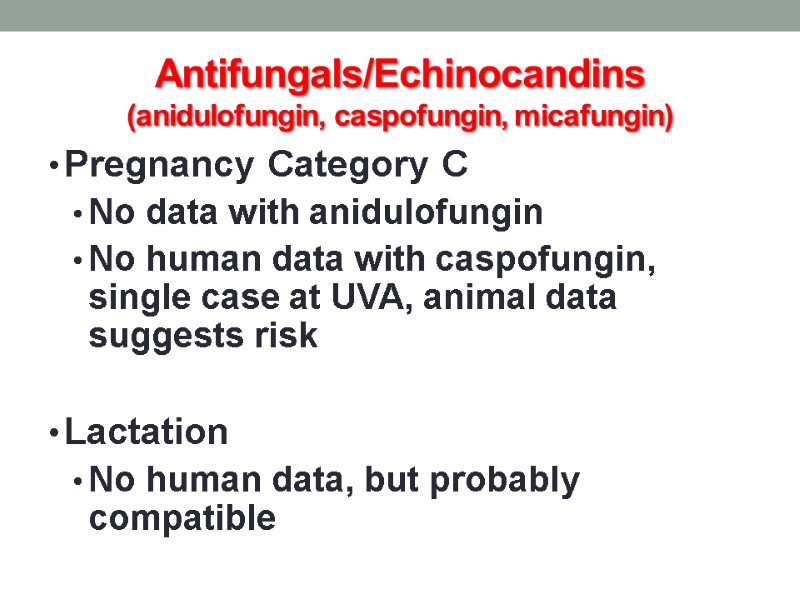
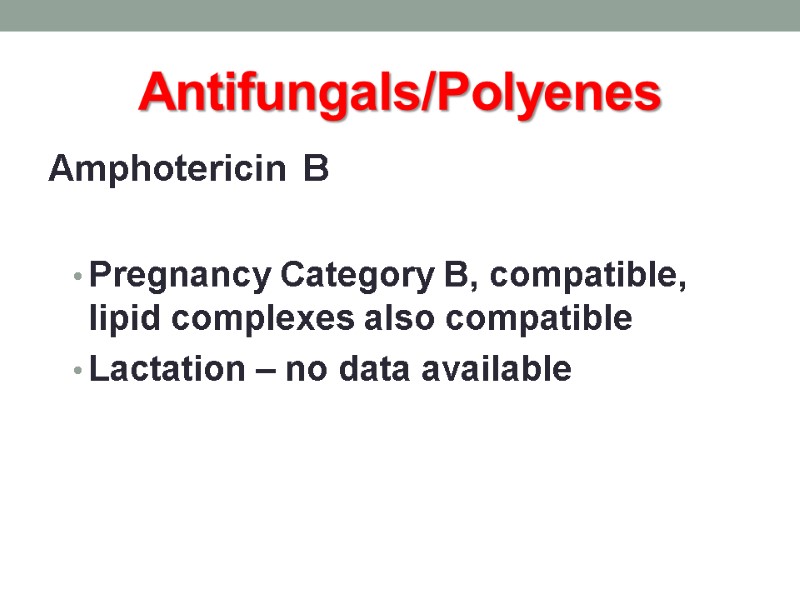
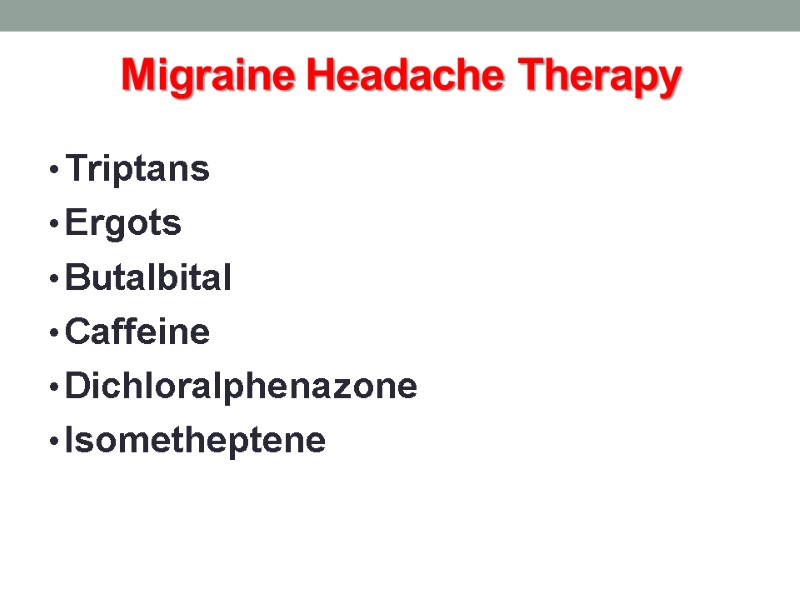
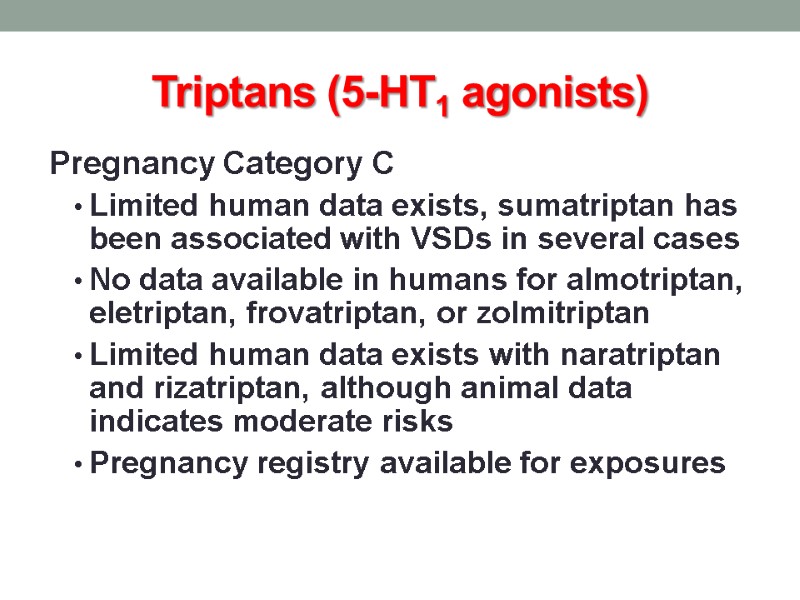
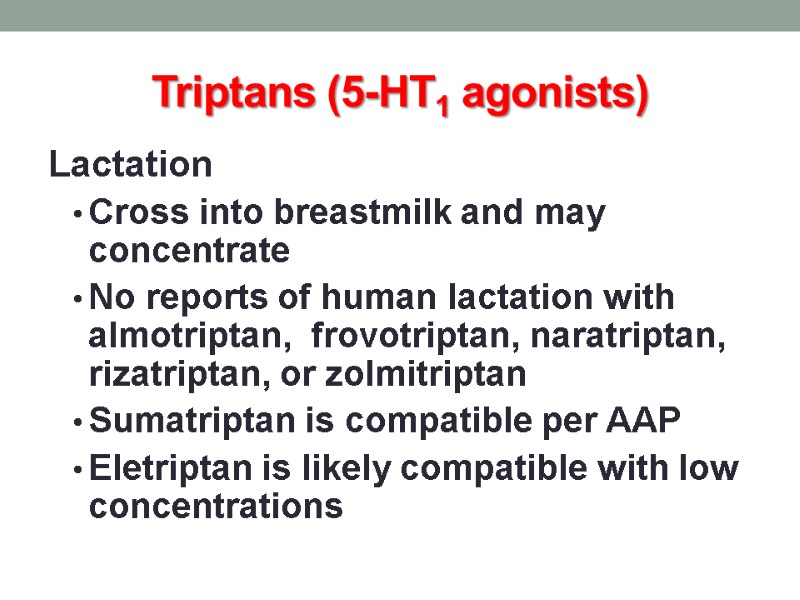
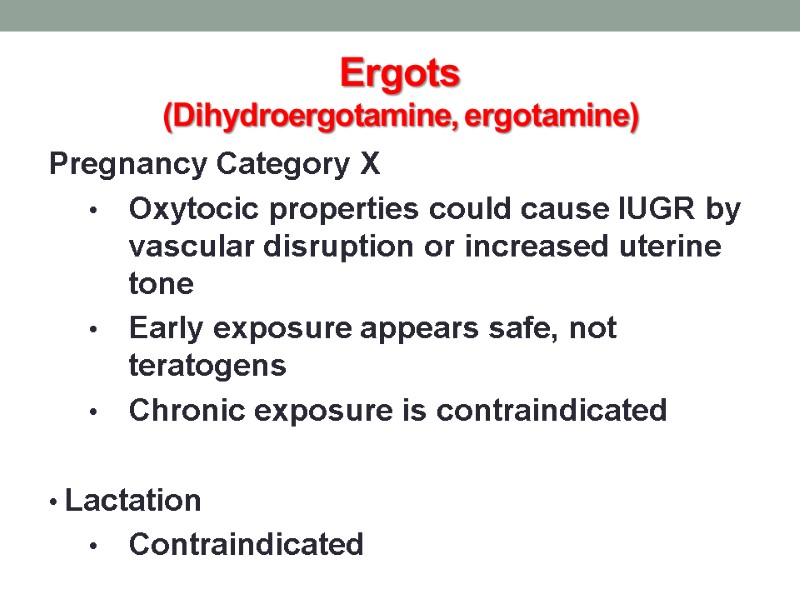
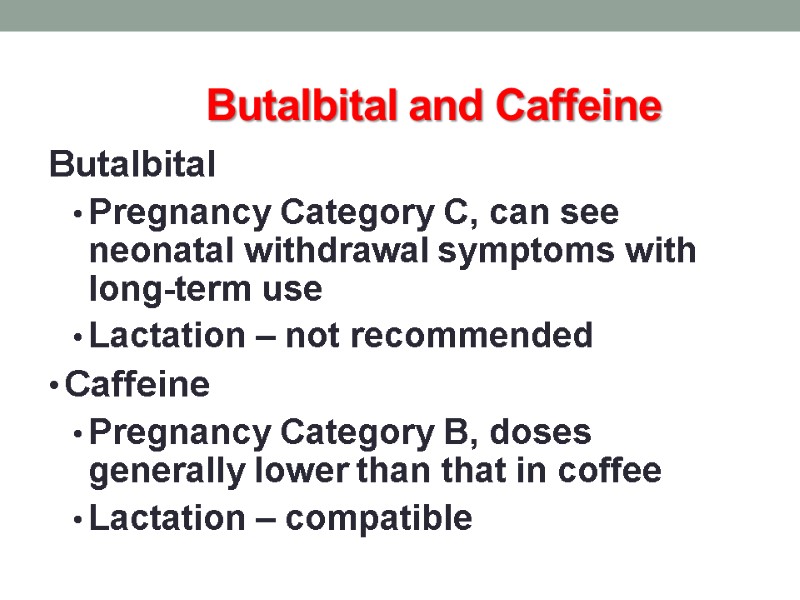
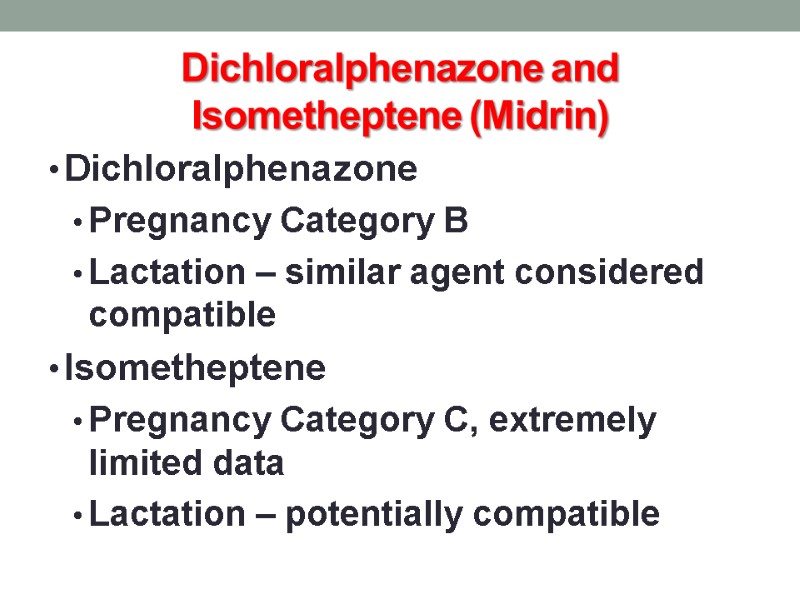
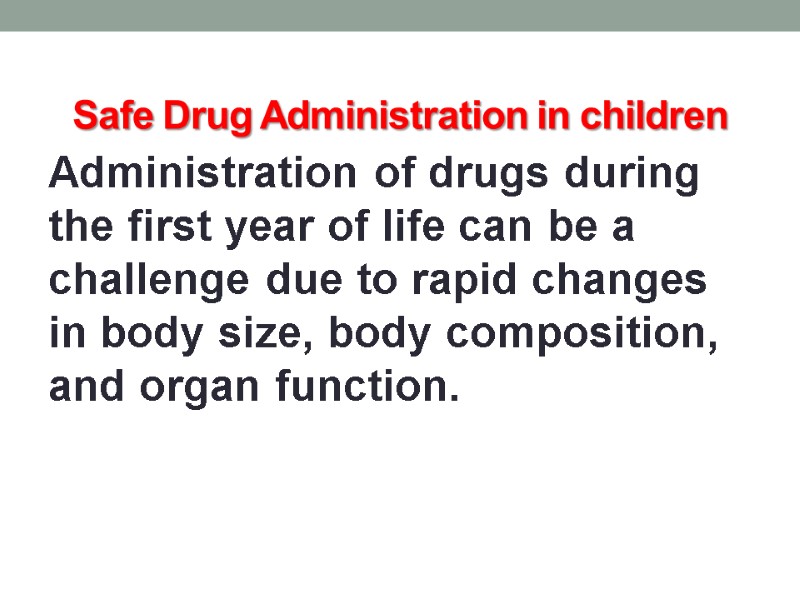
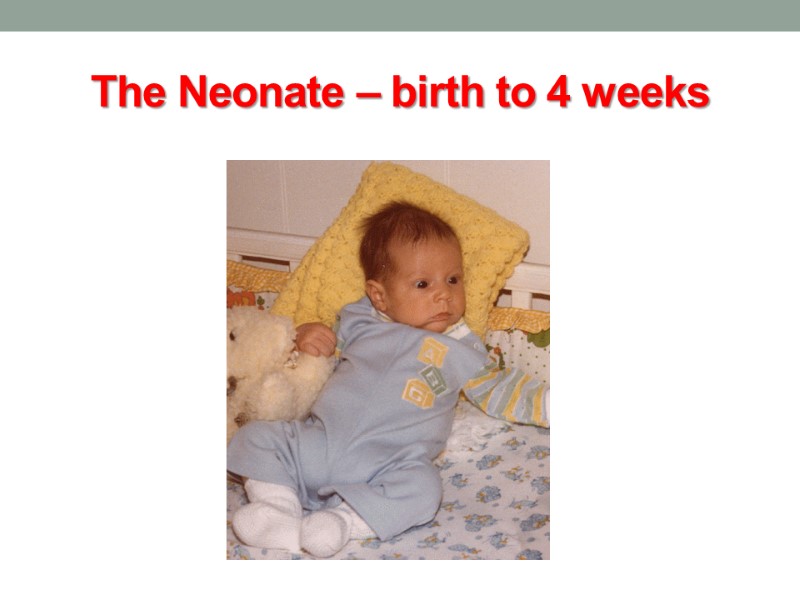
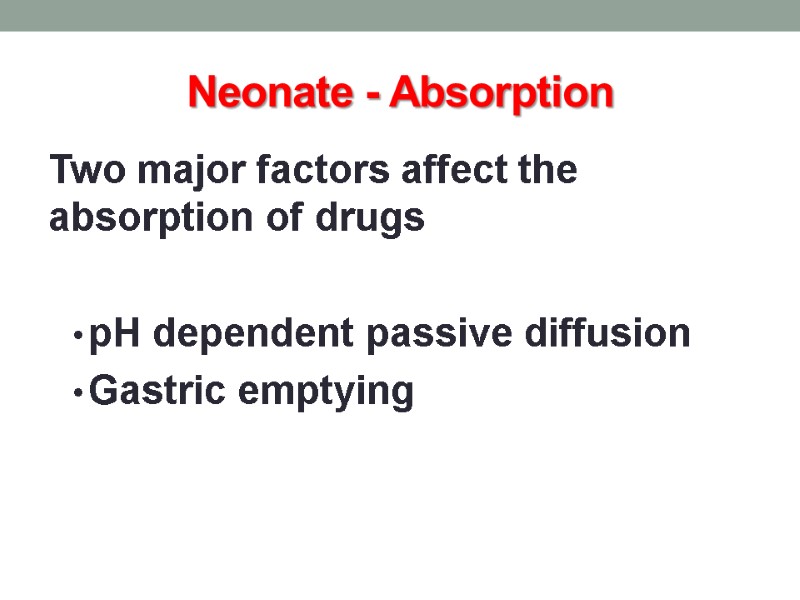
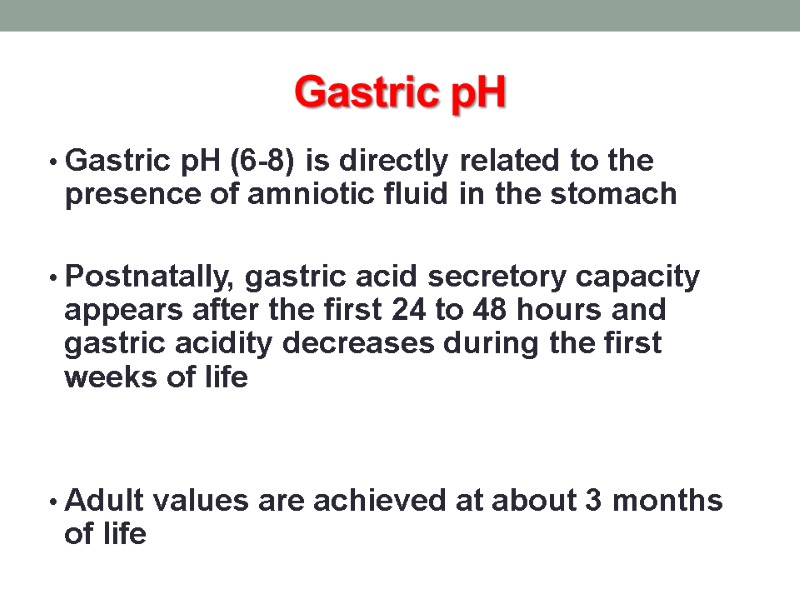
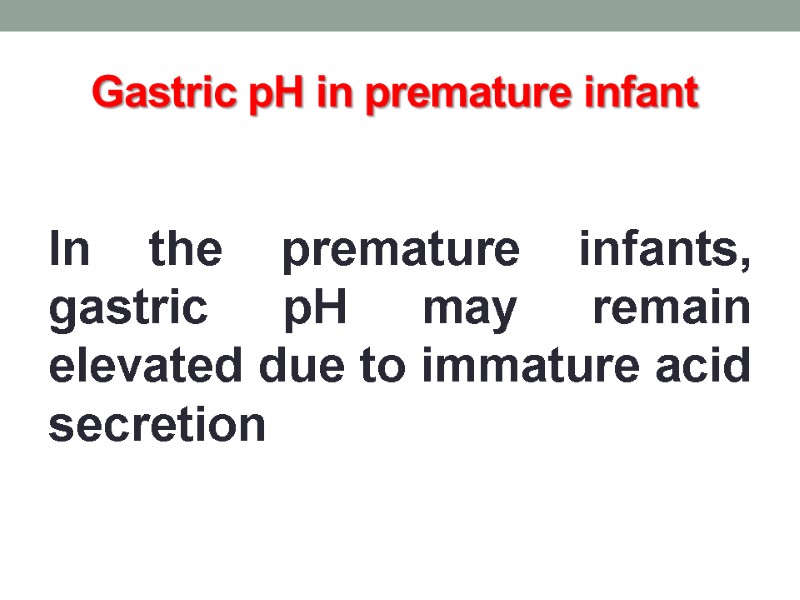
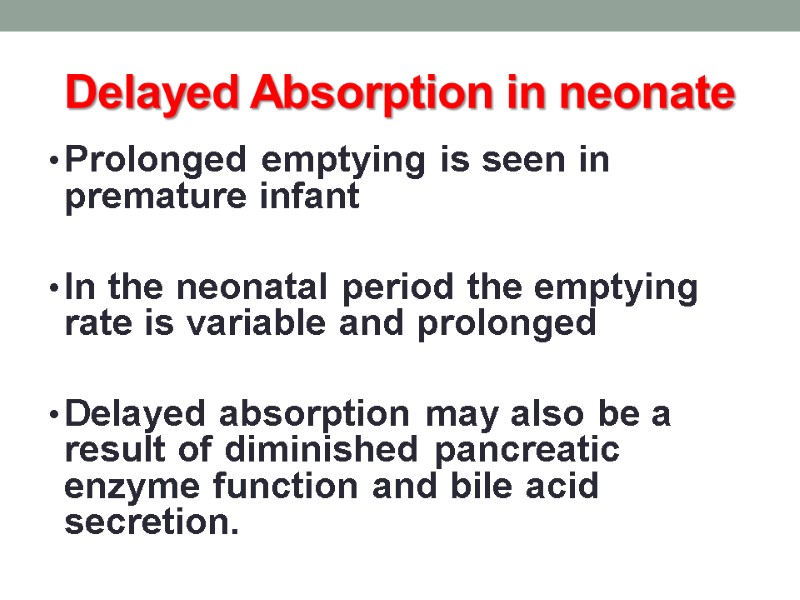
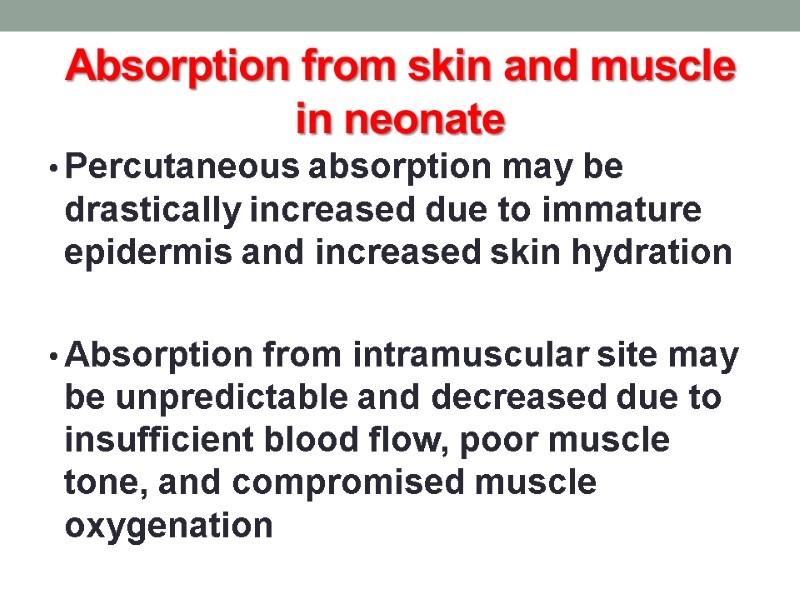
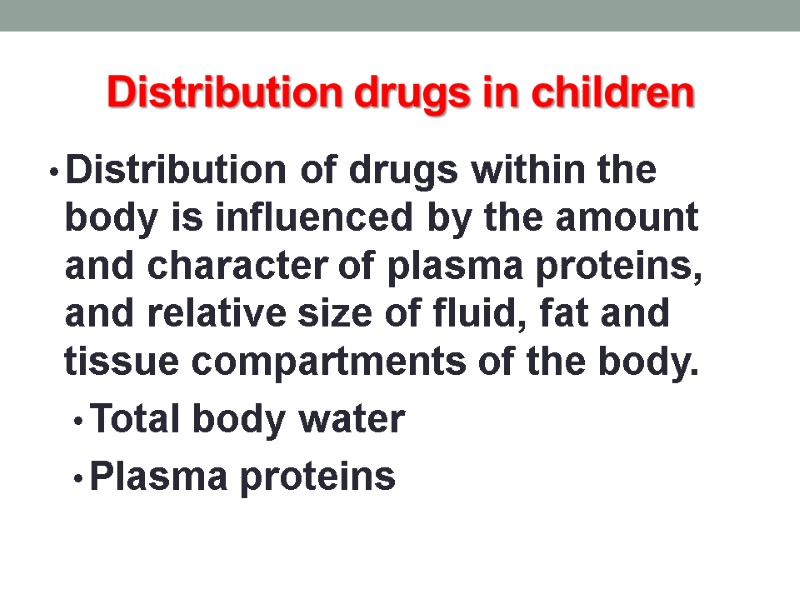
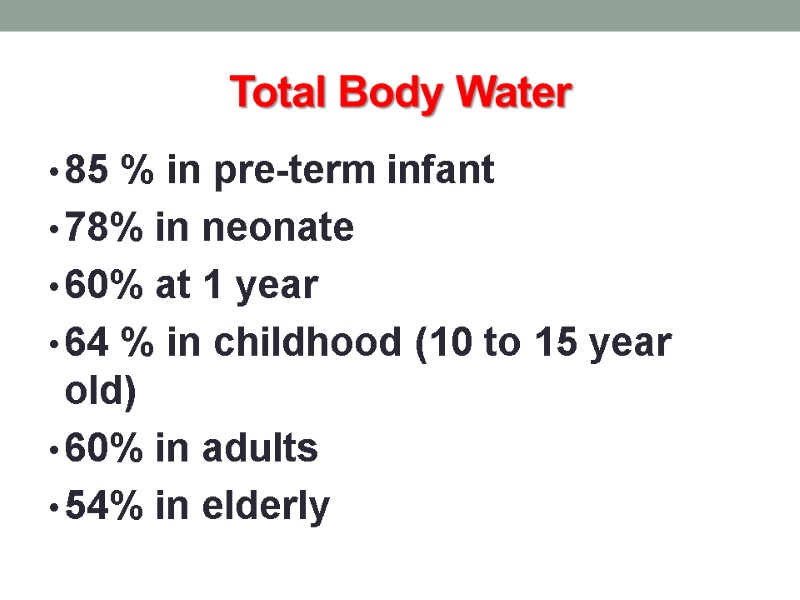
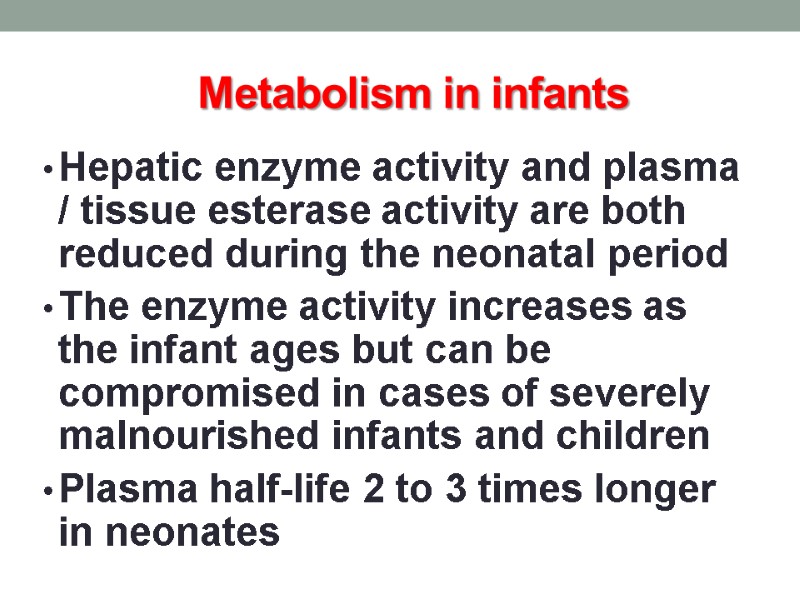
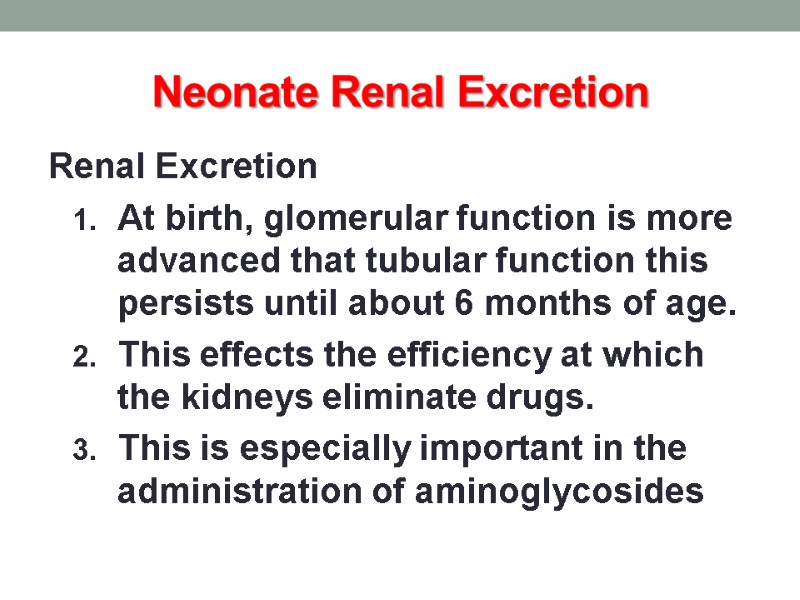
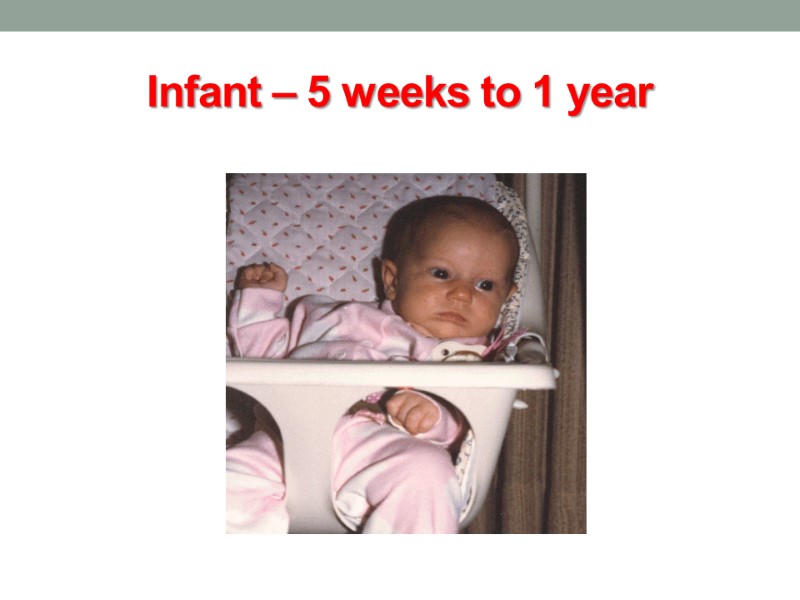
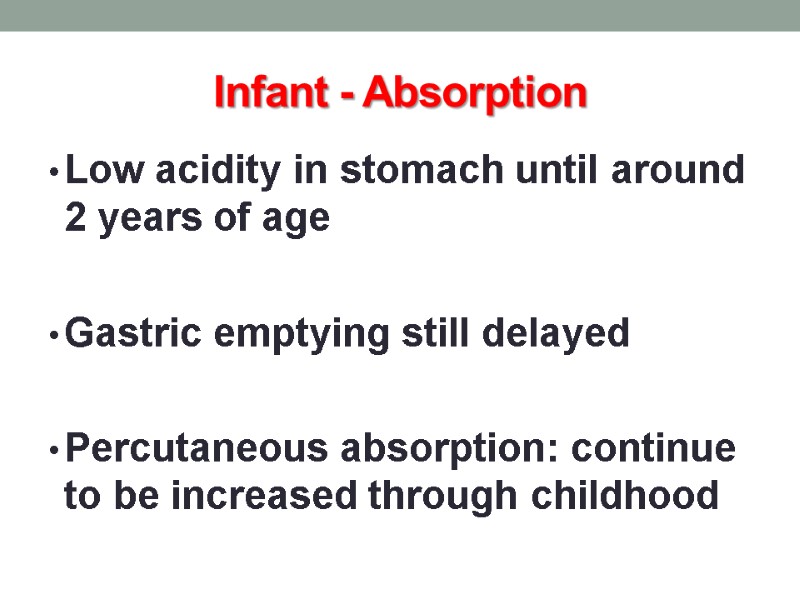
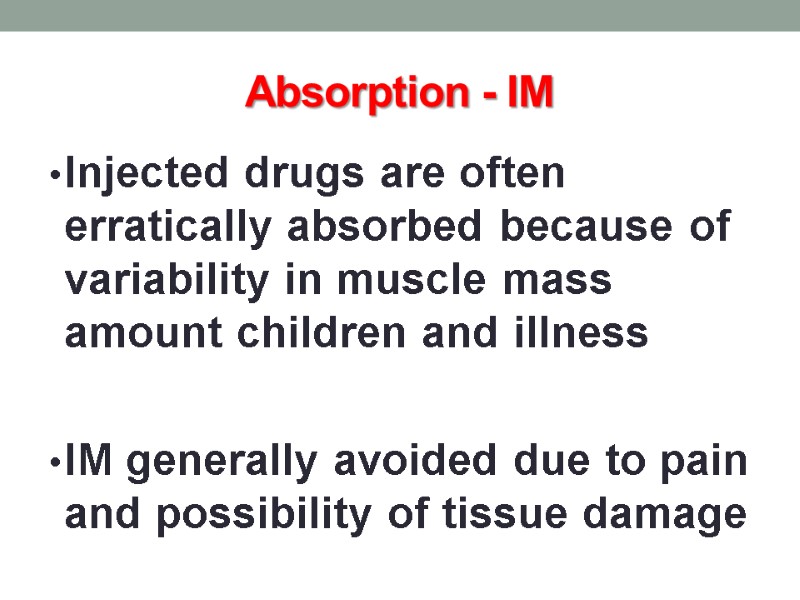
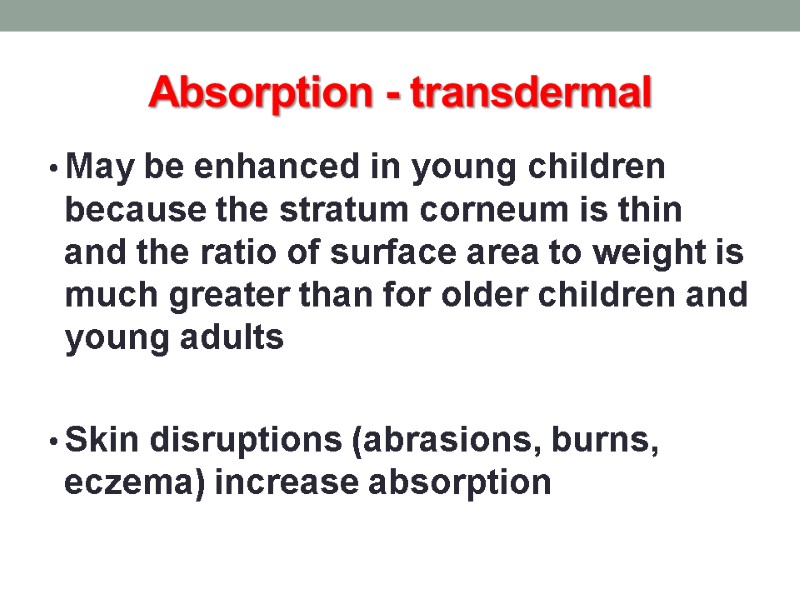
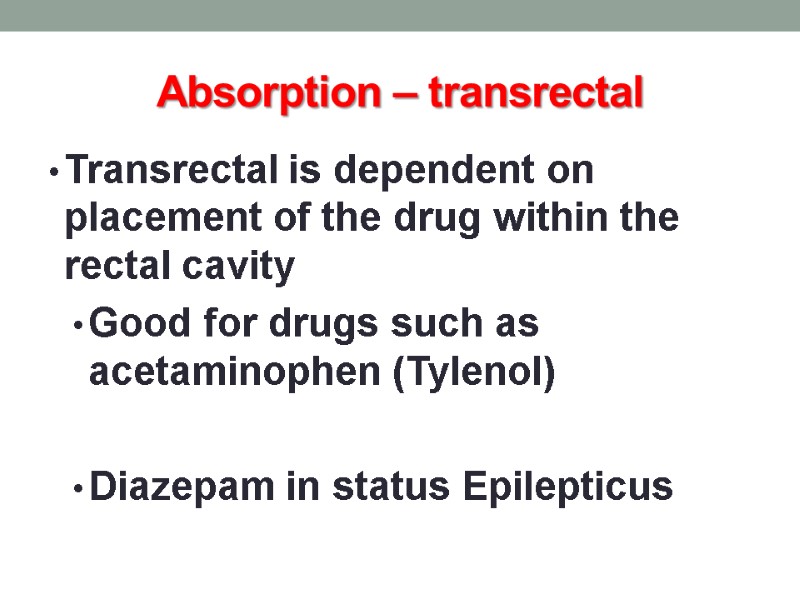
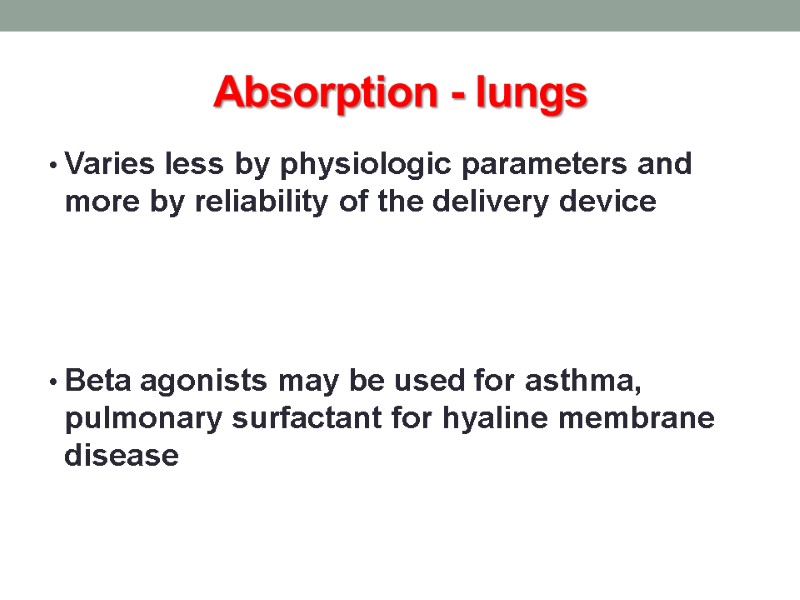
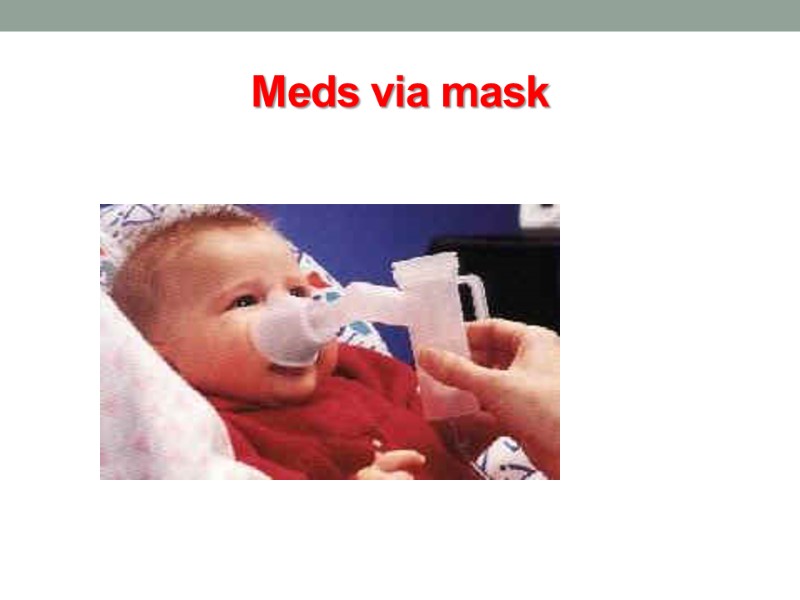
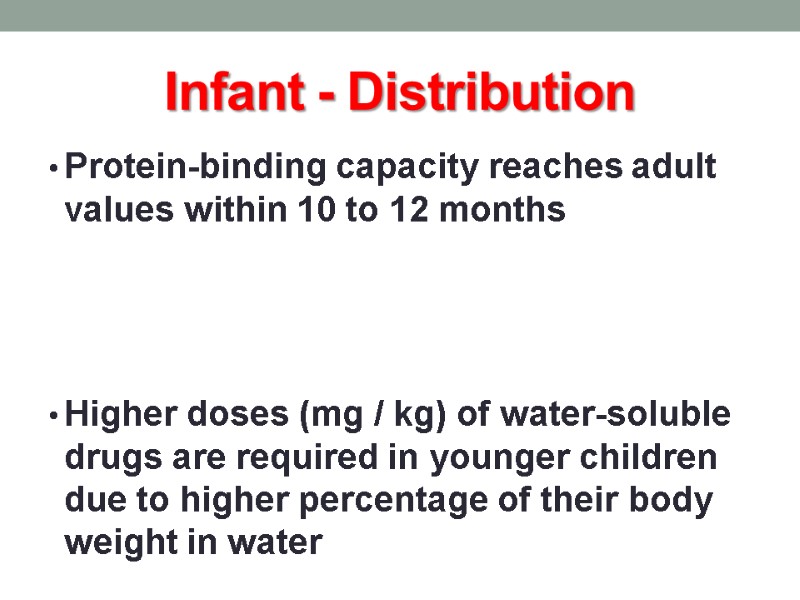
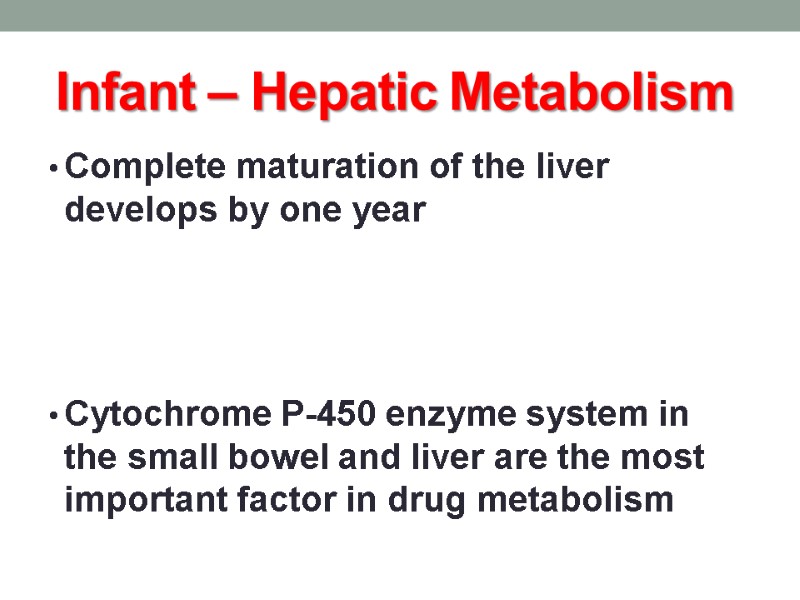
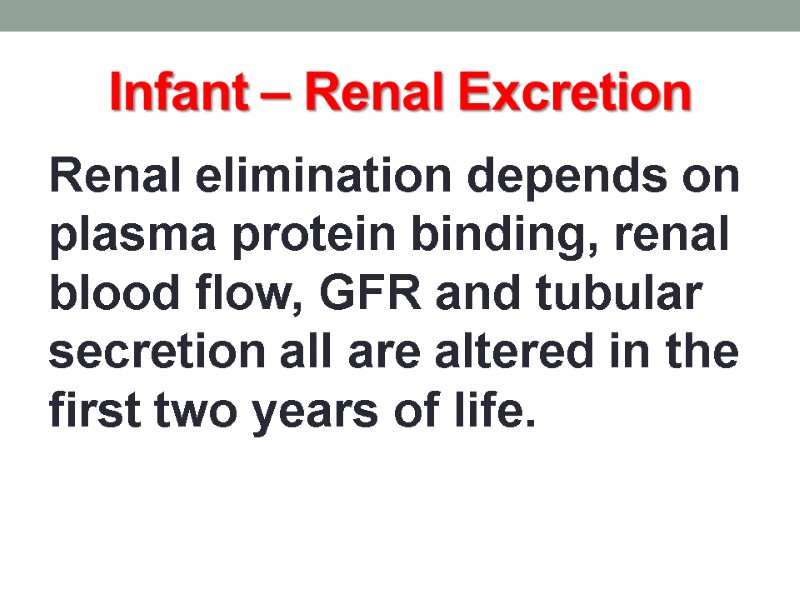
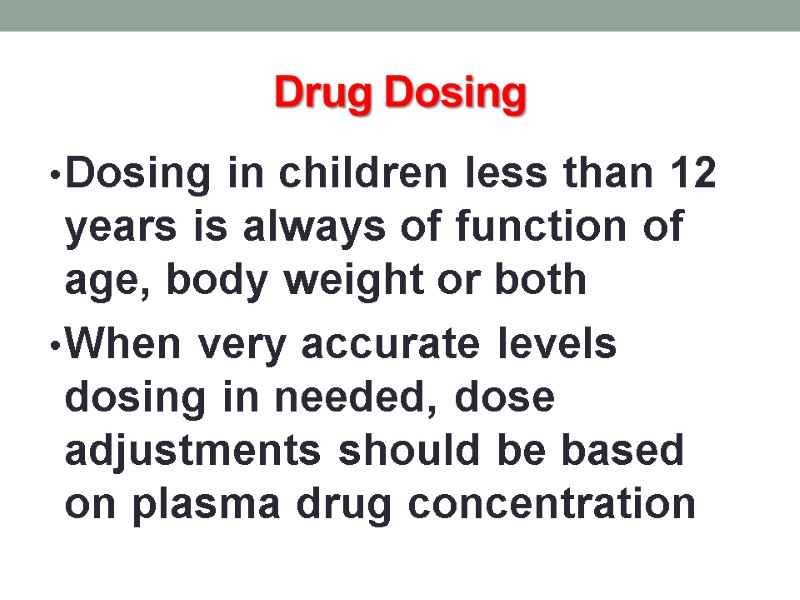
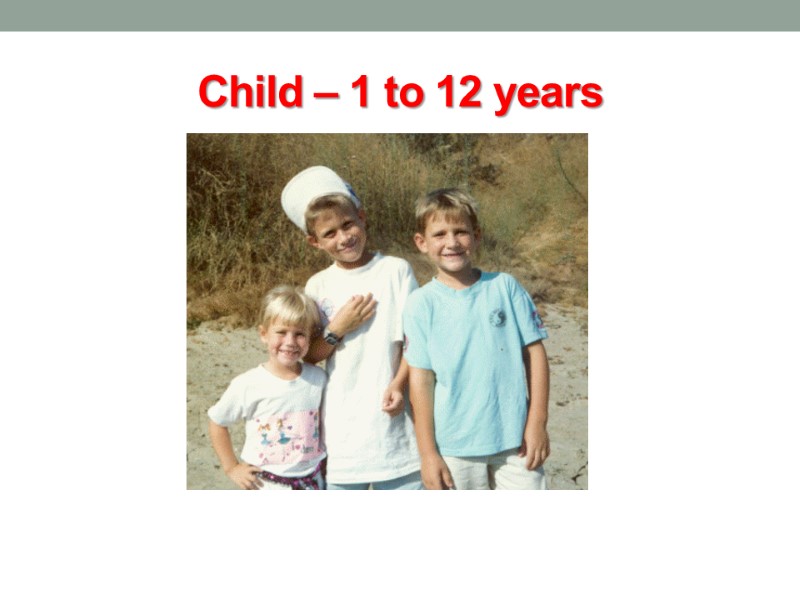
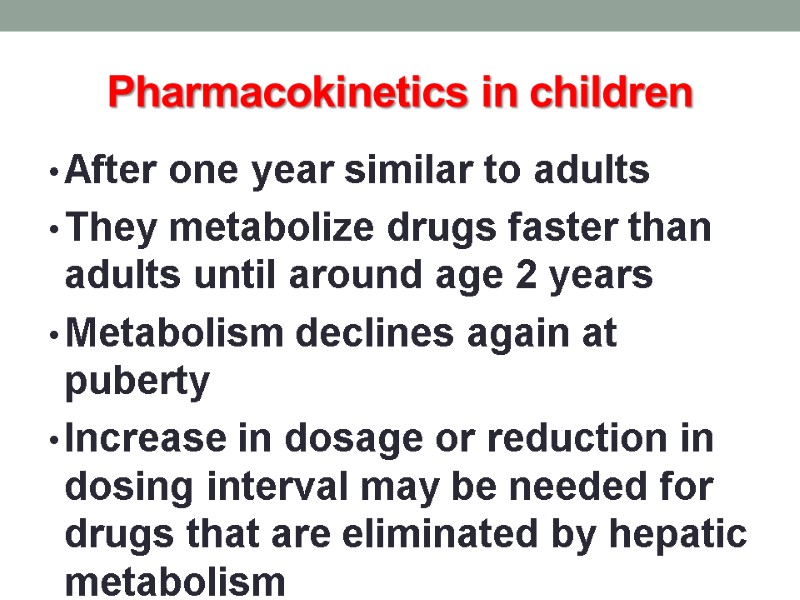
18148-drugs_used_in_pregnancy_02_10_2012.ppt
- Количество слайдов: 68
 Features of drugs action during pregnancy, lactation and in children
Features of drugs action during pregnancy, lactation and in children
 Drug use in pregnancy Drugs can be harmful for the unborn child!!! THE PLACENTA Drugs pass placenta by passive diffusion lipid barrier between maternal and embryonic/fetal circulations slow process (used during caesarean section) non-ionized drugs pass more rapidly most drugs are small enough to passexceptions: growth hormone, conjugated steroids cuts peak concentrations in maternal plasma
Drug use in pregnancy Drugs can be harmful for the unborn child!!! THE PLACENTA Drugs pass placenta by passive diffusion lipid barrier between maternal and embryonic/fetal circulations slow process (used during caesarean section) non-ionized drugs pass more rapidly most drugs are small enough to passexceptions: growth hormone, conjugated steroids cuts peak concentrations in maternal plasma
 Drug use in pregnancy effects of toxic drugs • malformation • growth retardation • fetal death • functional defects in newborn • premature birth Drugs should be used with caution during pregnancy
Drug use in pregnancy effects of toxic drugs • malformation • growth retardation • fetal death • functional defects in newborn • premature birth Drugs should be used with caution during pregnancy
 Drug use in pregnancy Use of drugs in pregnancy is not always wrong Some examples: • High fever is harmful for the fetus in the first months. Use of paracetamol is better then no treatment • Diabetes during pregnancy needs intensive therapy with insulin • Folic acid protects against spina bifida • Anti-epileptics are teratogenic. But an epileptic insult may provoke harmful anoxia for the fetus.
Drug use in pregnancy Use of drugs in pregnancy is not always wrong Some examples: • High fever is harmful for the fetus in the first months. Use of paracetamol is better then no treatment • Diabetes during pregnancy needs intensive therapy with insulin • Folic acid protects against spina bifida • Anti-epileptics are teratogenic. But an epileptic insult may provoke harmful anoxia for the fetus.
 Drug use in pregnancy Toxic chemicals and irradiation can damage Oocytes: • all female germ cells develop prenatally. No germ cells are formed after birth • Oocytes are in situ and not multiplying. • teratogenic effects can become apparent after fertilization, maybe long after the presence of damage • EMEA does not allow women with childbearing potential to take part in first in man studies
Drug use in pregnancy Toxic chemicals and irradiation can damage Oocytes: • all female germ cells develop prenatally. No germ cells are formed after birth • Oocytes are in situ and not multiplying. • teratogenic effects can become apparent after fertilization, maybe long after the presence of damage • EMEA does not allow women with childbearing potential to take part in first in man studies
 Drug use in pregnancy Is damaged sperm teratogenic? • Spermatozoa are continuously produced • Damaged spermatozoa are slower and arrive late when the oocytes is already fertilized → mostly not harmful? • May lead to infertility → paternal teratogenicity cannot fully be excluded. advice: use of condoms when the man is taking products that are suspected to be harmful termination of pregnancy because of paternal teratogenicity is not justified
Drug use in pregnancy Is damaged sperm teratogenic? • Spermatozoa are continuously produced • Damaged spermatozoa are slower and arrive late when the oocytes is already fertilized → mostly not harmful? • May lead to infertility → paternal teratogenicity cannot fully be excluded. advice: use of condoms when the man is taking products that are suspected to be harmful termination of pregnancy because of paternal teratogenicity is not justified
 Drug use in pregnancy The first trimester (day 8 – end of month 2) Is the most important period for teratogenicity Is period of formation of organs 3rd – 9th month Less risk for malformations except for urogenital tract and central nervous system More functional effects i.e. aminoglycosides nephro- & ototoxicity salicylates increased risk of bleeding
Drug use in pregnancy The first trimester (day 8 – end of month 2) Is the most important period for teratogenicity Is period of formation of organs 3rd – 9th month Less risk for malformations except for urogenital tract and central nervous system More functional effects i.e. aminoglycosides nephro- & ototoxicity salicylates increased risk of bleeding
 Drug use in pregnancy drugs have effects in newborn • avoid CNS depressants floppy infant syndrome • avoid drugs with increased bleeding risk like anticoagulants, salicylates increased risk of cerebral hemorrhage during delivery • NSAIDS and salicylates ↓ uterine contractility
Drug use in pregnancy drugs have effects in newborn • avoid CNS depressants floppy infant syndrome • avoid drugs with increased bleeding risk like anticoagulants, salicylates increased risk of cerebral hemorrhage during delivery • NSAIDS and salicylates ↓ uterine contractility
 Drug use in pregnancy spontaneous malformations (=unknown origin) 2-4 % Additional risk from drugs is small for most drugs evidence for teratogenic effects • golden standard is randomized controlled trial (RCT). ethical objections • epidemiologic studies cannot establish proven causality • large species differences in teratogenic effects No drug is proven free from teratogenic effects
Drug use in pregnancy spontaneous malformations (=unknown origin) 2-4 % Additional risk from drugs is small for most drugs evidence for teratogenic effects • golden standard is randomized controlled trial (RCT). ethical objections • epidemiologic studies cannot establish proven causality • large species differences in teratogenic effects No drug is proven free from teratogenic effects
 Drug use in pregnancy Risk classification (FDA) Category A: Controlled studies in women fail to demonstrate a risk to the fetus in the first trimester (and there is no evidence of a risk in later trimesters), and the possibility of fetal harm appears remote.
Drug use in pregnancy Risk classification (FDA) Category A: Controlled studies in women fail to demonstrate a risk to the fetus in the first trimester (and there is no evidence of a risk in later trimesters), and the possibility of fetal harm appears remote.
 Drug use in pregnancy Category B: Either animal reproduction studies have not demonstrated a fetal risk but there are no controlled studies in pregnant women, or animal-reproduction studies have shown an adverse effect (other than a decrease in fertility) that was not confirmed in controlled studies in women in the first trimester (and there is no evidence of a risk in later trimesters).
Drug use in pregnancy Category B: Either animal reproduction studies have not demonstrated a fetal risk but there are no controlled studies in pregnant women, or animal-reproduction studies have shown an adverse effect (other than a decrease in fertility) that was not confirmed in controlled studies in women in the first trimester (and there is no evidence of a risk in later trimesters).
 Drug use in pregnancy Category C: Either studies in animals have revealed adverse effects on the fetus (teratogenic or embryocidal or other) and there are no controlled studies in women, or studies in women and animals are not available. Drugs should be given only if the potential benefit justifies the potential risk to the fetus.
Drug use in pregnancy Category C: Either studies in animals have revealed adverse effects on the fetus (teratogenic or embryocidal or other) and there are no controlled studies in women, or studies in women and animals are not available. Drugs should be given only if the potential benefit justifies the potential risk to the fetus.
 Drug use in pregnancy Category D: There is positive evidence of human fetal risk, but the benefits from use in pregnant women may be acceptable despite the risk (e.g., if the drug is needed in a life-threatening situation or for a serious disease for which safer drugs cannot be used or are ineffective).
Drug use in pregnancy Category D: There is positive evidence of human fetal risk, but the benefits from use in pregnant women may be acceptable despite the risk (e.g., if the drug is needed in a life-threatening situation or for a serious disease for which safer drugs cannot be used or are ineffective).
 Drug use in pregnancy Category X: Studies in animals or human beings have demonstrated fetal abnormalities, or there is evidence of fetal risk based on human experience or both, and the risk of the use of the drug in pregnant women clearly outweighs any possible benefit. The drug is contraindicated in women who are or may become pregnant.
Drug use in pregnancy Category X: Studies in animals or human beings have demonstrated fetal abnormalities, or there is evidence of fetal risk based on human experience or both, and the risk of the use of the drug in pregnant women clearly outweighs any possible benefit. The drug is contraindicated in women who are or may become pregnant.
 Anti-infectives Penicillins Cephalosporins Carbapenems Fluoroquinolones Macrolides Aminoglycosides Sulfonamides Miscellaneous Antibiotics Antivirals Antiretrovirals Antifungals
Anti-infectives Penicillins Cephalosporins Carbapenems Fluoroquinolones Macrolides Aminoglycosides Sulfonamides Miscellaneous Antibiotics Antivirals Antiretrovirals Antifungals
 Penicillins Category B in pregnancy Cross the placenta easily and rapidly Concentrations equal maternal levels Lactation Crosses in low concentrations Compatible with breastfeeding
Penicillins Category B in pregnancy Cross the placenta easily and rapidly Concentrations equal maternal levels Lactation Crosses in low concentrations Compatible with breastfeeding
 Cephalosporins Category B in pregnancy Cross the placenta during pregnancy Some reports of increased anomalies with specific cephalosporins (cefaclor, cephalexin, cephradrine) Primarily cardiac and oral cleft defects Lactation Excreted into breastmilk in low concentrations Considered compatible with breastfeeding
Cephalosporins Category B in pregnancy Cross the placenta during pregnancy Some reports of increased anomalies with specific cephalosporins (cefaclor, cephalexin, cephradrine) Primarily cardiac and oral cleft defects Lactation Excreted into breastmilk in low concentrations Considered compatible with breastfeeding
 Carbapenems (ertapenem, imipenem, meropenem) Category B/C/B in pregnancy Likely cross the placenta Very little human data Lactation Excreted into breastmilk in low amounts Unknown effects but likely low clinical significance
Carbapenems (ertapenem, imipenem, meropenem) Category B/C/B in pregnancy Likely cross the placenta Very little human data Lactation Excreted into breastmilk in low amounts Unknown effects but likely low clinical significance
 Fluoroquinolones Pregnancy Category C Not recommended in pregnancy Cartilage damage in animals Safer alternatives usually exist Lactation Excreted into breastmilk Limited human data AAP says compatible with breastfeeding
Fluoroquinolones Pregnancy Category C Not recommended in pregnancy Cartilage damage in animals Safer alternatives usually exist Lactation Excreted into breastmilk Limited human data AAP says compatible with breastfeeding
 Macrolides (azithromycin, clarithromycin, erythromycin) Pregnancy Categories B/C/B Cross the placenta in low amounts Limited data with azithromycin and clarithromycin Lactation Erythromycin compatible Others probably compatible
Macrolides (azithromycin, clarithromycin, erythromycin) Pregnancy Categories B/C/B Cross the placenta in low amounts Limited data with azithromycin and clarithromycin Lactation Erythromycin compatible Others probably compatible
 Aminoglycosides (amikacin, gentamicin, tobramycin) Pregnancy Category C Rapidly cross placenta Enter amniotic fluid through fetal circulation Lactation Compatible with breastfeeding Not absorbed through GI tract
Aminoglycosides (amikacin, gentamicin, tobramycin) Pregnancy Category C Rapidly cross placenta Enter amniotic fluid through fetal circulation Lactation Compatible with breastfeeding Not absorbed through GI tract
 Sulfonamides Pregnancy Category C Readily cross the placenta Concerns of use at term Lactation Excreted into breastmilk in low levels Use should be avoided in premature infants
Sulfonamides Pregnancy Category C Readily cross the placenta Concerns of use at term Lactation Excreted into breastmilk in low levels Use should be avoided in premature infants
 Tetracyclines (doxycycline, minocycline, tetracycline) Pregnancy Category D Can cause problems with teeth and bone and other defects/effects Have been linked to maternal liver toxicity Lactation Compatible with breastfeeding Serum levels in infants undetectable
Tetracyclines (doxycycline, minocycline, tetracycline) Pregnancy Category D Can cause problems with teeth and bone and other defects/effects Have been linked to maternal liver toxicity Lactation Compatible with breastfeeding Serum levels in infants undetectable
 Miscellaneous Antibiotics Aztreonam Pregnancy Category B, likely safe in pregnancy, little human data Lactation – Compatible per AAP Clindamycin Pregnancy Category B, commonly used Lactation – Compatible per AAP
Miscellaneous Antibiotics Aztreonam Pregnancy Category B, likely safe in pregnancy, little human data Lactation – Compatible per AAP Clindamycin Pregnancy Category B, commonly used Lactation – Compatible per AAP
 Miscellaneous Antibiotics Linezolid Pregnancy Category C, no human data available Lactation – unknown, myelosuppression in animals Metronidazole Pregnancy Category B, carcinogenic in animals, avoid in 1st trimester if possible Lactation – hold feeds for 12-24hrs afterward
Miscellaneous Antibiotics Linezolid Pregnancy Category C, no human data available Lactation – unknown, myelosuppression in animals Metronidazole Pregnancy Category B, carcinogenic in animals, avoid in 1st trimester if possible Lactation – hold feeds for 12-24hrs afterward
 Miscellaneous Antibiotics Nitrofurantoin Pregnancy Category B, possible hemolytic anemia with use at term Lactation – Compatible, avoid with G-6-PD deficiency Trimethoprim Pregnancy Category C, potentially problematic early in pregnancy Lactation – Compatible as combination drug
Miscellaneous Antibiotics Nitrofurantoin Pregnancy Category B, possible hemolytic anemia with use at term Lactation – Compatible, avoid with G-6-PD deficiency Trimethoprim Pregnancy Category C, potentially problematic early in pregnancy Lactation – Compatible as combination drug
 Miscellaneous Antibiotics Vancomycin Pregnancy Category B, compatible Lactation – likely compatible, not absorbed
Miscellaneous Antibiotics Vancomycin Pregnancy Category B, compatible Lactation – likely compatible, not absorbed
 Antivirals (acyclovir, famciclovir, valacyclovir) Pregnancy Category B Acyclovir and valacyclovir readily cross the placenta Can be used for HSV treatment and suppression Lactation Acyclovir and valacyclovir are compatible Famciclovir should be avoided
Antivirals (acyclovir, famciclovir, valacyclovir) Pregnancy Category B Acyclovir and valacyclovir readily cross the placenta Can be used for HSV treatment and suppression Lactation Acyclovir and valacyclovir are compatible Famciclovir should be avoided
 Antiretrovirals/NRTI (abacavir, didanosine (ddI), emtricitabine (FTC)) Pregnancy Categories C/B/B Maternal benefit usually outweighs fetal risk Cross the placenta Limited data with each do not show increased risk of anomalies Didanosine has been associated with severe lactic acidosis w/ or w/o pancreatitis
Antiretrovirals/NRTI (abacavir, didanosine (ddI), emtricitabine (FTC)) Pregnancy Categories C/B/B Maternal benefit usually outweighs fetal risk Cross the placenta Limited data with each do not show increased risk of anomalies Didanosine has been associated with severe lactic acidosis w/ or w/o pancreatitis
 Antiretrovirals/NRTI (lamuvidine (3TC), stavudine (d4T)) Pregnancy Category C Maternal benefit usually outweighs fetal risk Cross the placenta by simple diffusion Data with lamivudine show no increased risk of anomalies Stavudine has been associated with severe lactic acidosis w/ or w/o pancreatitis All NRTIs have been possibly linked to mitochondrial dysfunction postnatally
Antiretrovirals/NRTI (lamuvidine (3TC), stavudine (d4T)) Pregnancy Category C Maternal benefit usually outweighs fetal risk Cross the placenta by simple diffusion Data with lamivudine show no increased risk of anomalies Stavudine has been associated with severe lactic acidosis w/ or w/o pancreatitis All NRTIs have been possibly linked to mitochondrial dysfunction postnatally
 Antiretrovirals/NRTI (tenofivir, zalcitabine (ddC), zidovudine (AZT)) Pregnancy Category B/C/C Maternal benefit usually outweighs fetal risk Cross the placenta by simple diffusion Limited data with zalcitabine do not show increased risk of anomalies Zidovudine is commonly used, but may cause neonatal anemia Limited data with tenofivir show low risk of teratogenicity
Antiretrovirals/NRTI (tenofivir, zalcitabine (ddC), zidovudine (AZT)) Pregnancy Category B/C/C Maternal benefit usually outweighs fetal risk Cross the placenta by simple diffusion Limited data with zalcitabine do not show increased risk of anomalies Zidovudine is commonly used, but may cause neonatal anemia Limited data with tenofivir show low risk of teratogenicity
 Antiretrovirals/NNRTI (delavirdine, efavirenz, nevirapine) Pregnancy Category C Maternal risk usually outweighs fetal risk Likely cross into fetus (nevirapine readily) Delavirdine has possible VSD risk, but limited human data Efavirenz is associated with anomalies in monkeys, limited human data, possible NTD Nevirapine can cause hepatotoxicity and rash Nevirapine can be used as a single dose in labor to prevent HIV transmission
Antiretrovirals/NNRTI (delavirdine, efavirenz, nevirapine) Pregnancy Category C Maternal risk usually outweighs fetal risk Likely cross into fetus (nevirapine readily) Delavirdine has possible VSD risk, but limited human data Efavirenz is associated with anomalies in monkeys, limited human data, possible NTD Nevirapine can cause hepatotoxicity and rash Nevirapine can be used as a single dose in labor to prevent HIV transmission
 Antiretrovirals/PI Pregnancy Category B/C Maternal benefit usually outweighs fetal risk Likely cross the placenta All PIs can cause hyperglycemia Atazanavir can cause hyperbilirubinemia Indinavir can cause nephrolithiasis
Antiretrovirals/PI Pregnancy Category B/C Maternal benefit usually outweighs fetal risk Likely cross the placenta All PIs can cause hyperglycemia Atazanavir can cause hyperbilirubinemia Indinavir can cause nephrolithiasis
 Antiretrovirals/Fusion Inhibitor (enfuvirtide) Pregnancy Category B Maternal benefit usually outweighs fetal risk Very large molecule (4492 daltons), likely does not cross placenta Animal data does not show risk No human data available Hold during first trimester if possible
Antiretrovirals/Fusion Inhibitor (enfuvirtide) Pregnancy Category B Maternal benefit usually outweighs fetal risk Very large molecule (4492 daltons), likely does not cross placenta Animal data does not show risk No human data available Hold during first trimester if possible
 Antifungals/Azoles (fluconazole, itraconazole, ketoconazole, posaconazole, voriconazole) Pregnancy Categories C/C/C/D/D Likely cross placenta Fluconazole > 400mg/day seems to be associated with cranio-facial abnormalities Itraconazole appears to have low risk Ketoconazole can impair testosterone and cortisol synthesis No data in humans is available for voriconazole, increased risk in animals
Antifungals/Azoles (fluconazole, itraconazole, ketoconazole, posaconazole, voriconazole) Pregnancy Categories C/C/C/D/D Likely cross placenta Fluconazole > 400mg/day seems to be associated with cranio-facial abnormalities Itraconazole appears to have low risk Ketoconazole can impair testosterone and cortisol synthesis No data in humans is available for voriconazole, increased risk in animals
 Antifungals/Azoles (fluconazole, itraconazole, ketoconazole, posaconazole, voriconazole) Lactation Fluconazole is compatible per AAP Itraconazole could concentrate in milk and body tissues, not recommended Ketoconazole is compatible per AAP No data with voriconazole, not recommended
Antifungals/Azoles (fluconazole, itraconazole, ketoconazole, posaconazole, voriconazole) Lactation Fluconazole is compatible per AAP Itraconazole could concentrate in milk and body tissues, not recommended Ketoconazole is compatible per AAP No data with voriconazole, not recommended
 Antifungals/Echinocandins (anidulofungin, caspofungin, micafungin) Pregnancy Category C No data with anidulofungin No human data with caspofungin, single case at UVA, animal data suggests risk Lactation No human data, but probably compatible
Antifungals/Echinocandins (anidulofungin, caspofungin, micafungin) Pregnancy Category C No data with anidulofungin No human data with caspofungin, single case at UVA, animal data suggests risk Lactation No human data, but probably compatible
 Antifungals/Polyenes Amphotericin B Pregnancy Category B, compatible, lipid complexes also compatible Lactation – no data available
Antifungals/Polyenes Amphotericin B Pregnancy Category B, compatible, lipid complexes also compatible Lactation – no data available
 Migraine Headache Therapy Triptans Ergots Butalbital Caffeine Dichloralphenazone Isometheptene
Migraine Headache Therapy Triptans Ergots Butalbital Caffeine Dichloralphenazone Isometheptene
 Triptans (5-HT1 agonists) Pregnancy Category C Limited human data exists, sumatriptan has been associated with VSDs in several cases No data available in humans for almotriptan, eletriptan, frovatriptan, or zolmitriptan Limited human data exists with naratriptan and rizatriptan, although animal data indicates moderate risks Pregnancy registry available for exposures
Triptans (5-HT1 agonists) Pregnancy Category C Limited human data exists, sumatriptan has been associated with VSDs in several cases No data available in humans for almotriptan, eletriptan, frovatriptan, or zolmitriptan Limited human data exists with naratriptan and rizatriptan, although animal data indicates moderate risks Pregnancy registry available for exposures
 Triptans (5-HT1 agonists) Lactation Cross into breastmilk and may concentrate No reports of human lactation with almotriptan, frovotriptan, naratriptan, rizatriptan, or zolmitriptan Sumatriptan is compatible per AAP Eletriptan is likely compatible with low concentrations
Triptans (5-HT1 agonists) Lactation Cross into breastmilk and may concentrate No reports of human lactation with almotriptan, frovotriptan, naratriptan, rizatriptan, or zolmitriptan Sumatriptan is compatible per AAP Eletriptan is likely compatible with low concentrations
 Ergots (Dihydroergotamine, ergotamine) Pregnancy Category X Oxytocic properties could cause IUGR by vascular disruption or increased uterine tone Early exposure appears safe, not teratogens Chronic exposure is contraindicated Lactation Contraindicated
Ergots (Dihydroergotamine, ergotamine) Pregnancy Category X Oxytocic properties could cause IUGR by vascular disruption or increased uterine tone Early exposure appears safe, not teratogens Chronic exposure is contraindicated Lactation Contraindicated
 Butalbital and Caffeine Butalbital Pregnancy Category C, can see neonatal withdrawal symptoms with long-term use Lactation – not recommended Caffeine Pregnancy Category B, doses generally lower than that in coffee Lactation – compatible
Butalbital and Caffeine Butalbital Pregnancy Category C, can see neonatal withdrawal symptoms with long-term use Lactation – not recommended Caffeine Pregnancy Category B, doses generally lower than that in coffee Lactation – compatible
 Dichloralphenazone and Isometheptene (Midrin) Dichloralphenazone Pregnancy Category B Lactation – similar agent considered compatible Isometheptene Pregnancy Category C, extremely limited data Lactation – potentially compatible
Dichloralphenazone and Isometheptene (Midrin) Dichloralphenazone Pregnancy Category B Lactation – similar agent considered compatible Isometheptene Pregnancy Category C, extremely limited data Lactation – potentially compatible
 Safe Drug Administration in children Administration of drugs during the first year of life can be a challenge due to rapid changes in body size, body composition, and organ function.
Safe Drug Administration in children Administration of drugs during the first year of life can be a challenge due to rapid changes in body size, body composition, and organ function.
 The Neonate – birth to 4 weeks
The Neonate – birth to 4 weeks
 Neonate - Absorption Two major factors affect the absorption of drugs pH dependent passive diffusion Gastric emptying
Neonate - Absorption Two major factors affect the absorption of drugs pH dependent passive diffusion Gastric emptying
 Gastric pH Gastric pH (6-8) is directly related to the presence of amniotic fluid in the stomach Postnatally, gastric acid secretory capacity appears after the first 24 to 48 hours and gastric acidity decreases during the first weeks of life Adult values are achieved at about 3 months of life
Gastric pH Gastric pH (6-8) is directly related to the presence of amniotic fluid in the stomach Postnatally, gastric acid secretory capacity appears after the first 24 to 48 hours and gastric acidity decreases during the first weeks of life Adult values are achieved at about 3 months of life
 Gastric pH in premature infant In the premature infants, gastric pH may remain elevated due to immature acid secretion
Gastric pH in premature infant In the premature infants, gastric pH may remain elevated due to immature acid secretion
 Delayed Absorption in neonate Prolonged emptying is seen in premature infant In the neonatal period the emptying rate is variable and prolonged Delayed absorption may also be a result of diminished pancreatic enzyme function and bile acid secretion.
Delayed Absorption in neonate Prolonged emptying is seen in premature infant In the neonatal period the emptying rate is variable and prolonged Delayed absorption may also be a result of diminished pancreatic enzyme function and bile acid secretion.
 Absorption from skin and muscle in neonate Percutaneous absorption may be drastically increased due to immature epidermis and increased skin hydration Absorption from intramuscular site may be unpredictable and decreased due to insufficient blood flow, poor muscle tone, and compromised muscle oxygenation
Absorption from skin and muscle in neonate Percutaneous absorption may be drastically increased due to immature epidermis and increased skin hydration Absorption from intramuscular site may be unpredictable and decreased due to insufficient blood flow, poor muscle tone, and compromised muscle oxygenation
 Distribution drugs in children Distribution of drugs within the body is influenced by the amount and character of plasma proteins, and relative size of fluid, fat and tissue compartments of the body. Total body water Plasma proteins
Distribution drugs in children Distribution of drugs within the body is influenced by the amount and character of plasma proteins, and relative size of fluid, fat and tissue compartments of the body. Total body water Plasma proteins
 Total Body Water 85 % in pre-term infant 78% in neonate 60% at 1 year 64 % in childhood (10 to 15 year old) 60% in adults 54% in elderly
Total Body Water 85 % in pre-term infant 78% in neonate 60% at 1 year 64 % in childhood (10 to 15 year old) 60% in adults 54% in elderly
 Metabolism in infants Hepatic enzyme activity and plasma / tissue esterase activity are both reduced during the neonatal period The enzyme activity increases as the infant ages but can be compromised in cases of severely malnourished infants and children Plasma half-life 2 to 3 times longer in neonates
Metabolism in infants Hepatic enzyme activity and plasma / tissue esterase activity are both reduced during the neonatal period The enzyme activity increases as the infant ages but can be compromised in cases of severely malnourished infants and children Plasma half-life 2 to 3 times longer in neonates
 Neonate Renal Excretion Renal Excretion At birth, glomerular function is more advanced that tubular function this persists until about 6 months of age. This effects the efficiency at which the kidneys eliminate drugs. This is especially important in the administration of aminoglycosides
Neonate Renal Excretion Renal Excretion At birth, glomerular function is more advanced that tubular function this persists until about 6 months of age. This effects the efficiency at which the kidneys eliminate drugs. This is especially important in the administration of aminoglycosides
 Infant – 5 weeks to 1 year
Infant – 5 weeks to 1 year
 Infant - Absorption Low acidity in stomach until around 2 years of age Gastric emptying still delayed Percutaneous absorption: continue to be increased through childhood
Infant - Absorption Low acidity in stomach until around 2 years of age Gastric emptying still delayed Percutaneous absorption: continue to be increased through childhood
 Absorption - IM Injected drugs are often erratically absorbed because of variability in muscle mass amount children and illness IM generally avoided due to pain and possibility of tissue damage
Absorption - IM Injected drugs are often erratically absorbed because of variability in muscle mass amount children and illness IM generally avoided due to pain and possibility of tissue damage
 Absorption - transdermal May be enhanced in young children because the stratum corneum is thin and the ratio of surface area to weight is much greater than for older children and young adults Skin disruptions (abrasions, burns, eczema) increase absorption
Absorption - transdermal May be enhanced in young children because the stratum corneum is thin and the ratio of surface area to weight is much greater than for older children and young adults Skin disruptions (abrasions, burns, eczema) increase absorption
 Absorption – transrectal Transrectal is dependent on placement of the drug within the rectal cavity Good for drugs such as acetaminophen (Tylenol) Diazepam in status Epilepticus
Absorption – transrectal Transrectal is dependent on placement of the drug within the rectal cavity Good for drugs such as acetaminophen (Tylenol) Diazepam in status Epilepticus
 Absorption - lungs Varies less by physiologic parameters and more by reliability of the delivery device Beta agonists may be used for asthma, pulmonary surfactant for hyaline membrane disease
Absorption - lungs Varies less by physiologic parameters and more by reliability of the delivery device Beta agonists may be used for asthma, pulmonary surfactant for hyaline membrane disease
 Meds via mask
Meds via mask
 Infant - Distribution Protein-binding capacity reaches adult values within 10 to 12 months Higher doses (mg / kg) of water-soluble drugs are required in younger children due to higher percentage of their body weight in water
Infant - Distribution Protein-binding capacity reaches adult values within 10 to 12 months Higher doses (mg / kg) of water-soluble drugs are required in younger children due to higher percentage of their body weight in water
 Infant – Hepatic Metabolism Complete maturation of the liver develops by one year Cytochrome P-450 enzyme system in the small bowel and liver are the most important factor in drug metabolism
Infant – Hepatic Metabolism Complete maturation of the liver develops by one year Cytochrome P-450 enzyme system in the small bowel and liver are the most important factor in drug metabolism
 Infant – Renal Excretion Renal elimination depends on plasma protein binding, renal blood flow, GFR and tubular secretion all are altered in the first two years of life.
Infant – Renal Excretion Renal elimination depends on plasma protein binding, renal blood flow, GFR and tubular secretion all are altered in the first two years of life.
 Drug Dosing Dosing in children less than 12 years is always of function of age, body weight or both When very accurate levels dosing in needed, dose adjustments should be based on plasma drug concentration
Drug Dosing Dosing in children less than 12 years is always of function of age, body weight or both When very accurate levels dosing in needed, dose adjustments should be based on plasma drug concentration
 Child – 1 to 12 years
Child – 1 to 12 years
 Pharmacokinetics in children After one year similar to adults They metabolize drugs faster than adults until around age 2 years Metabolism declines again at puberty Increase in dosage or reduction in dosing interval may be needed for drugs that are eliminated by hepatic metabolism
Pharmacokinetics in children After one year similar to adults They metabolize drugs faster than adults until around age 2 years Metabolism declines again at puberty Increase in dosage or reduction in dosing interval may be needed for drugs that are eliminated by hepatic metabolism
